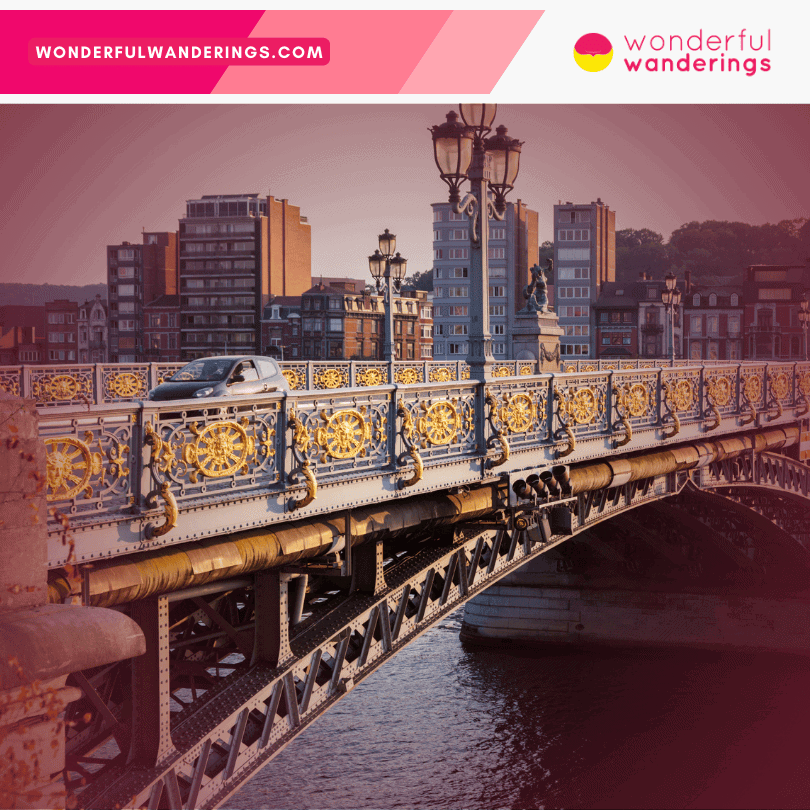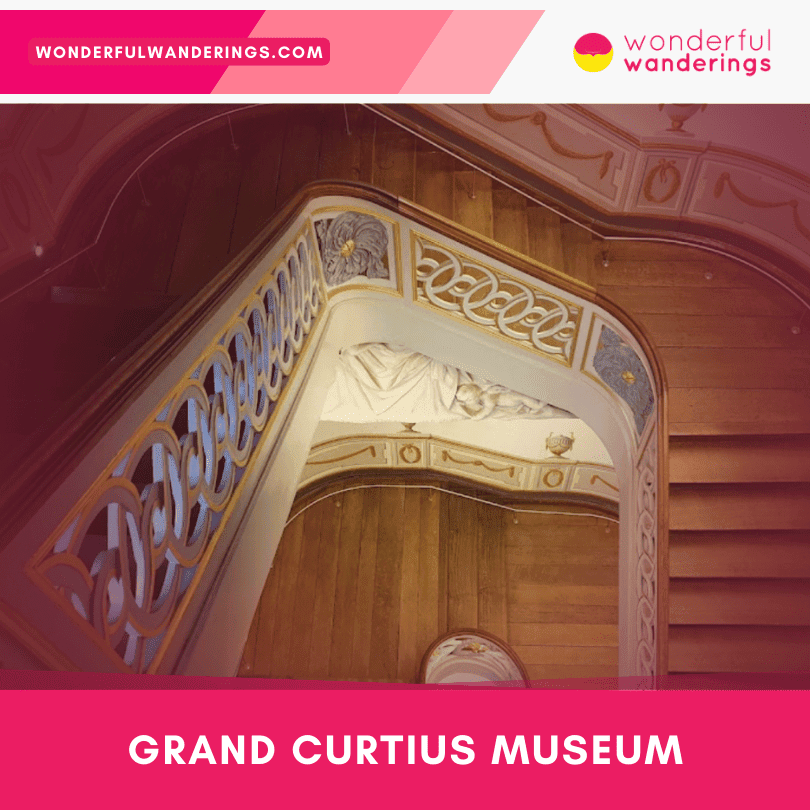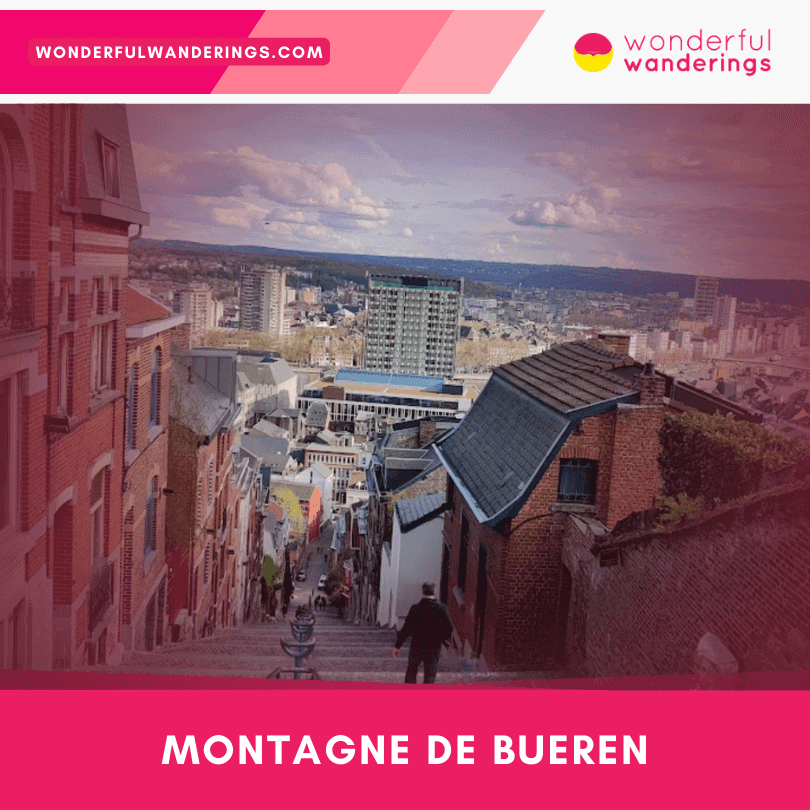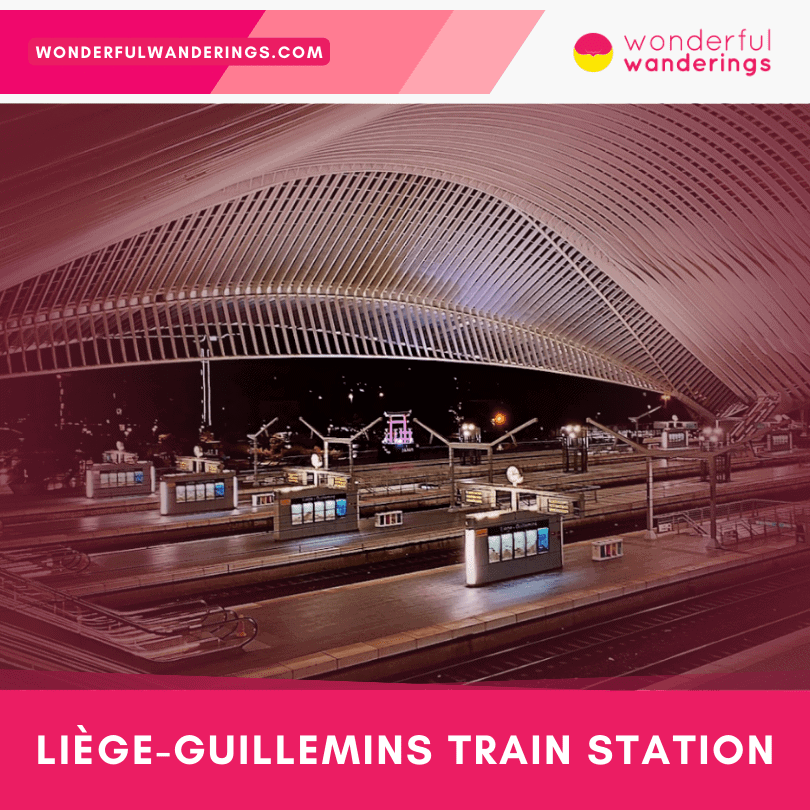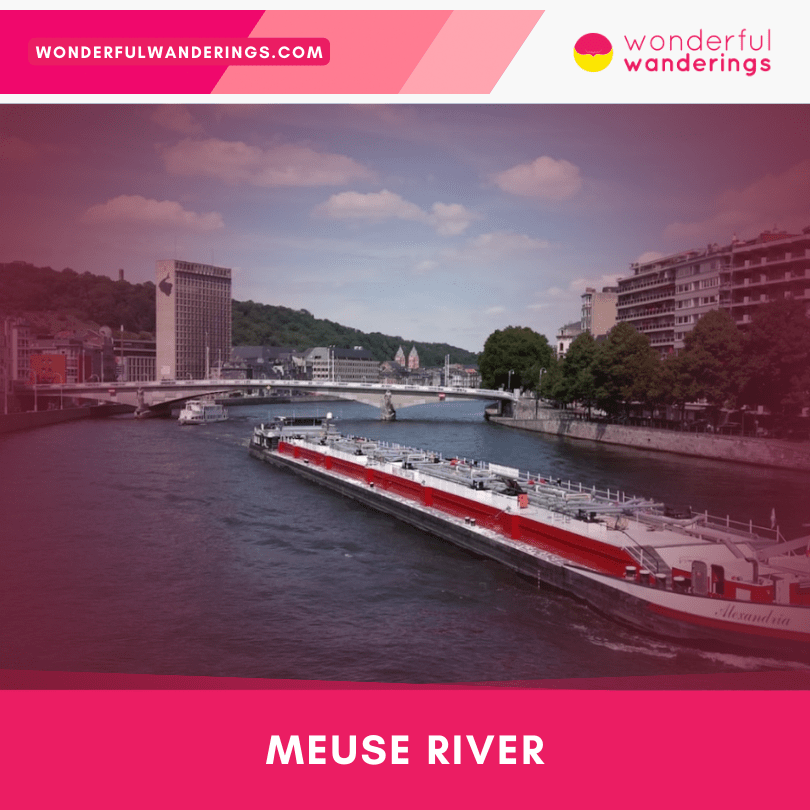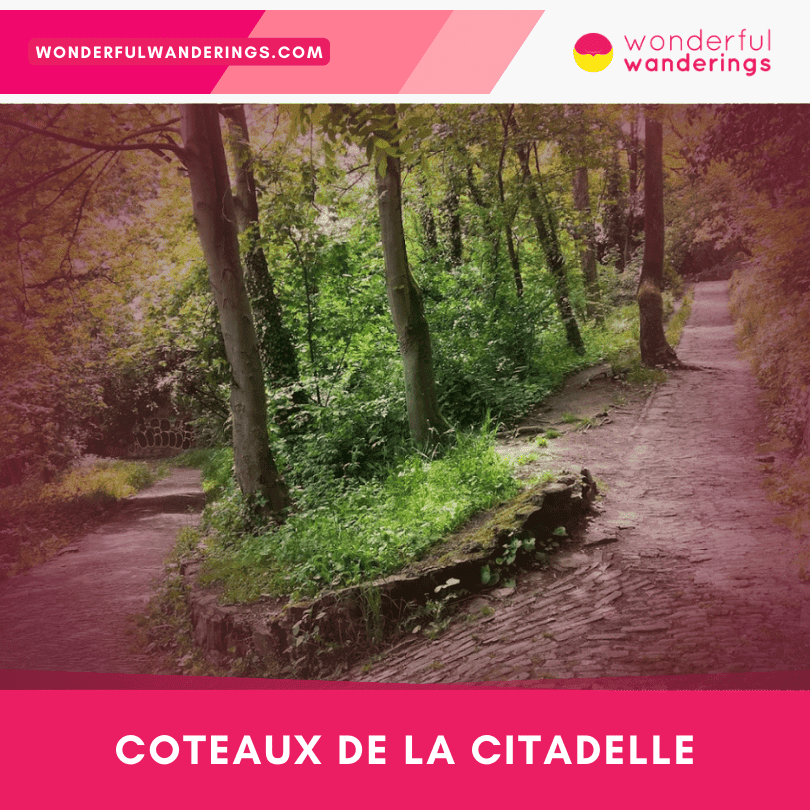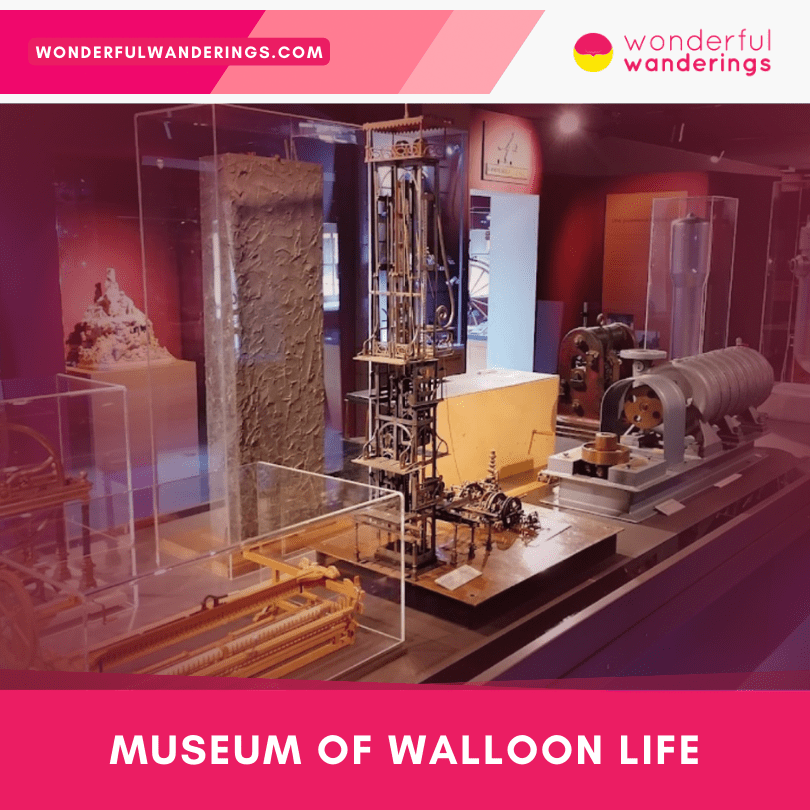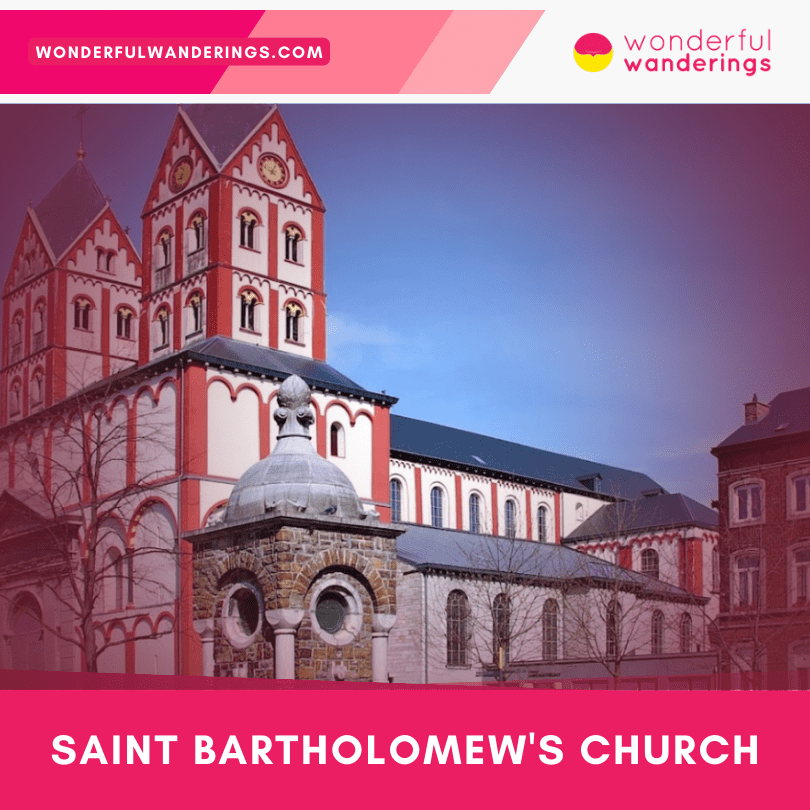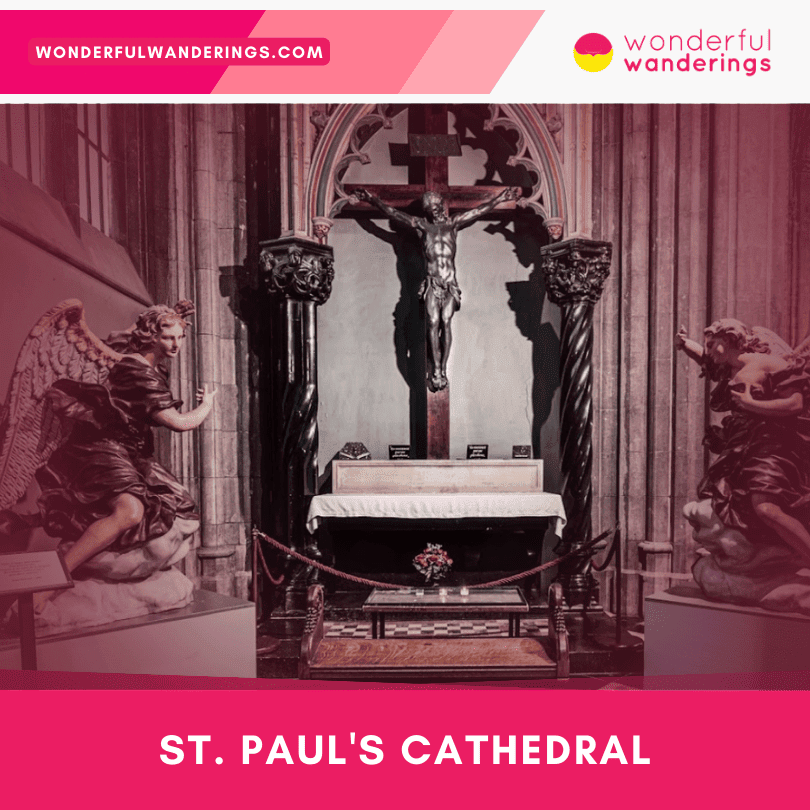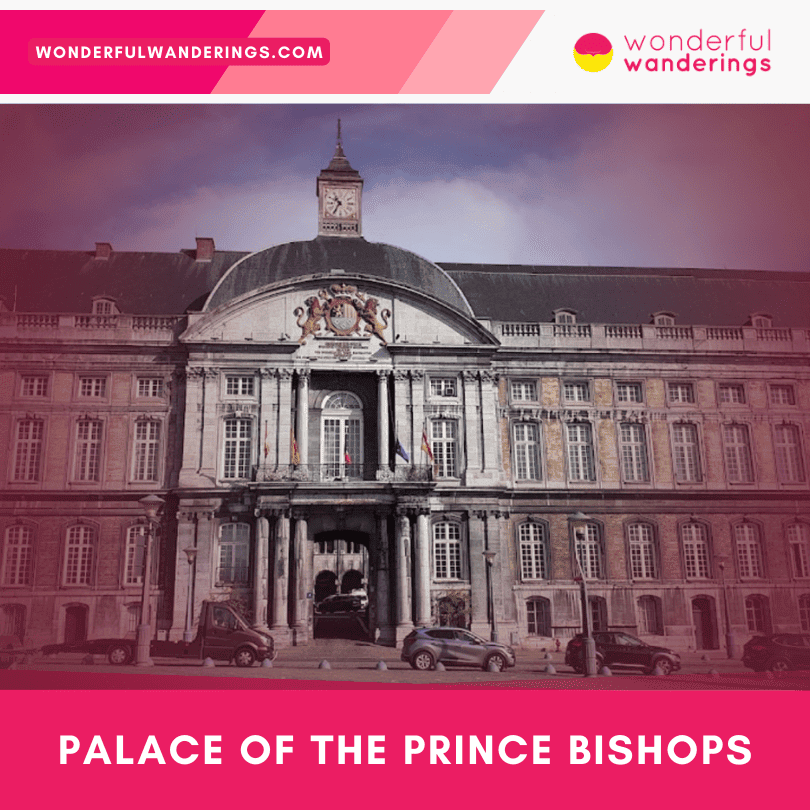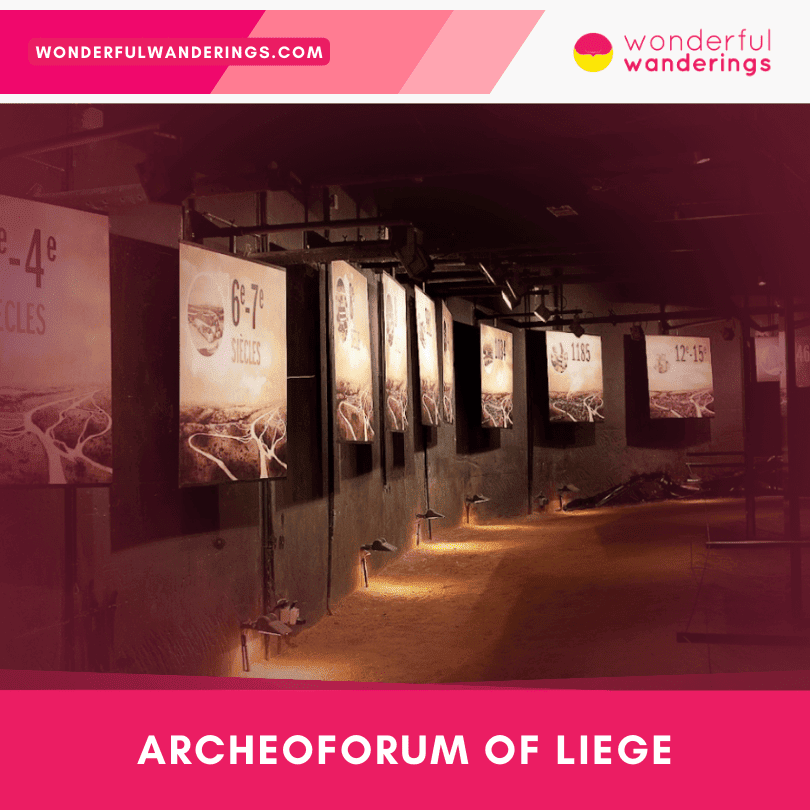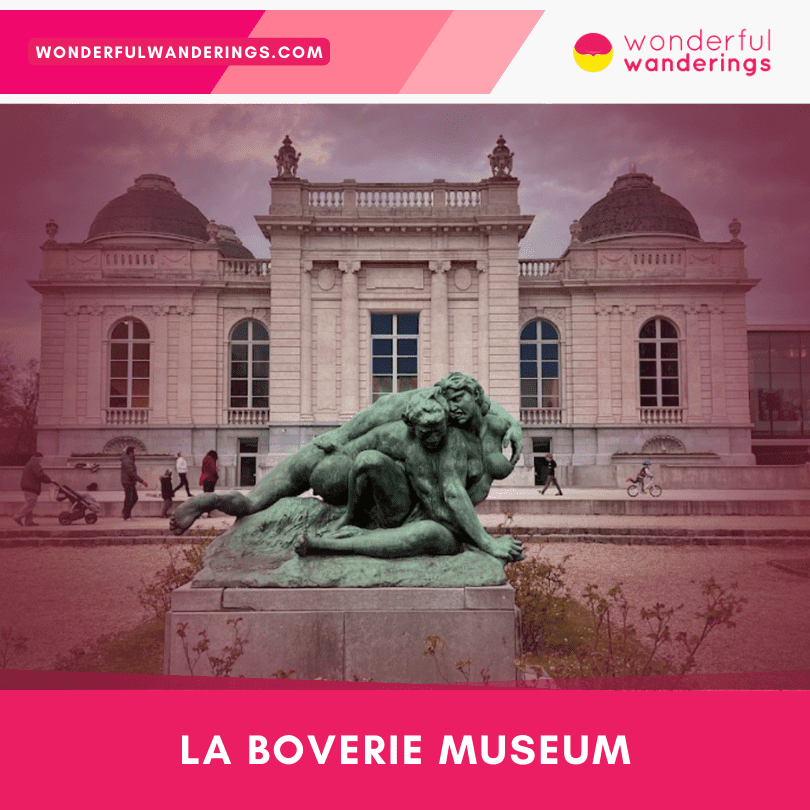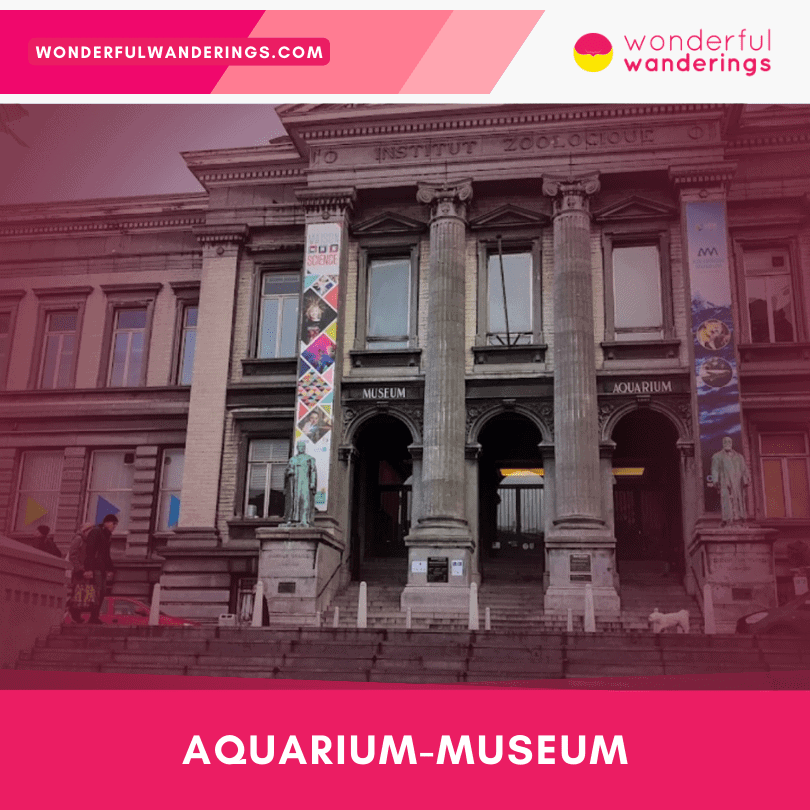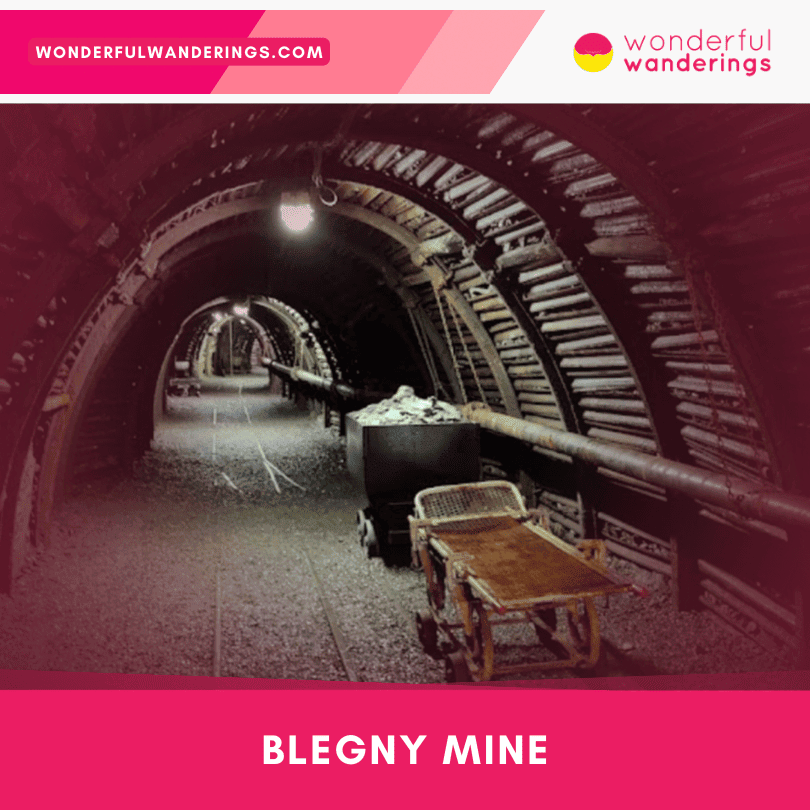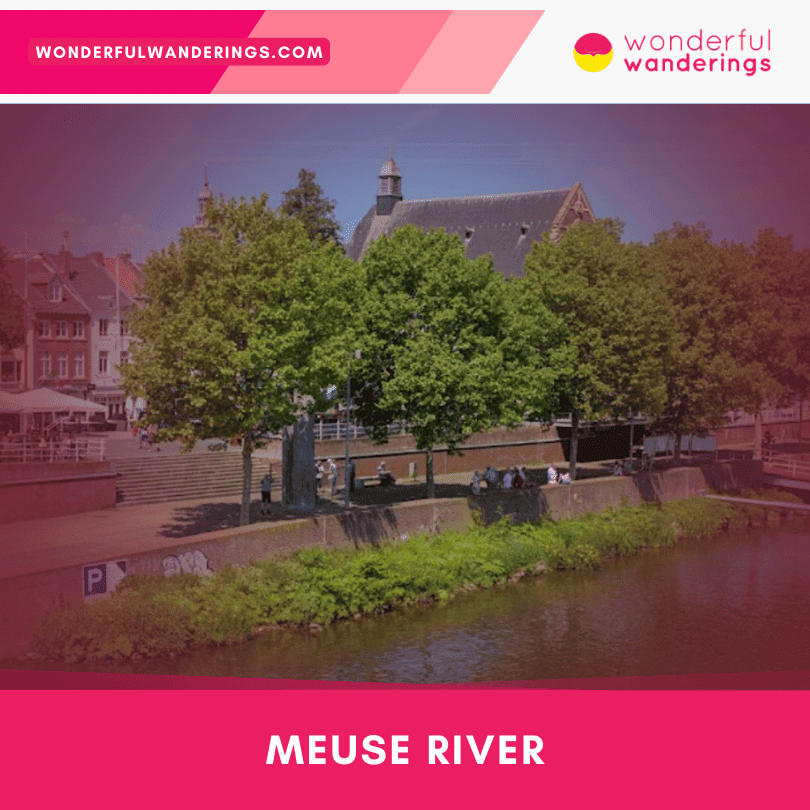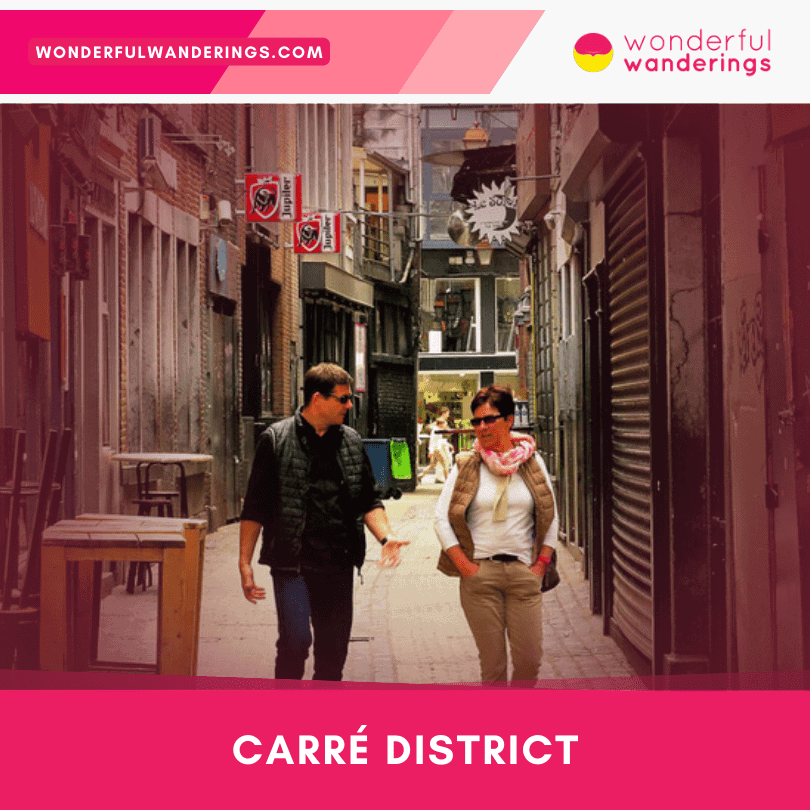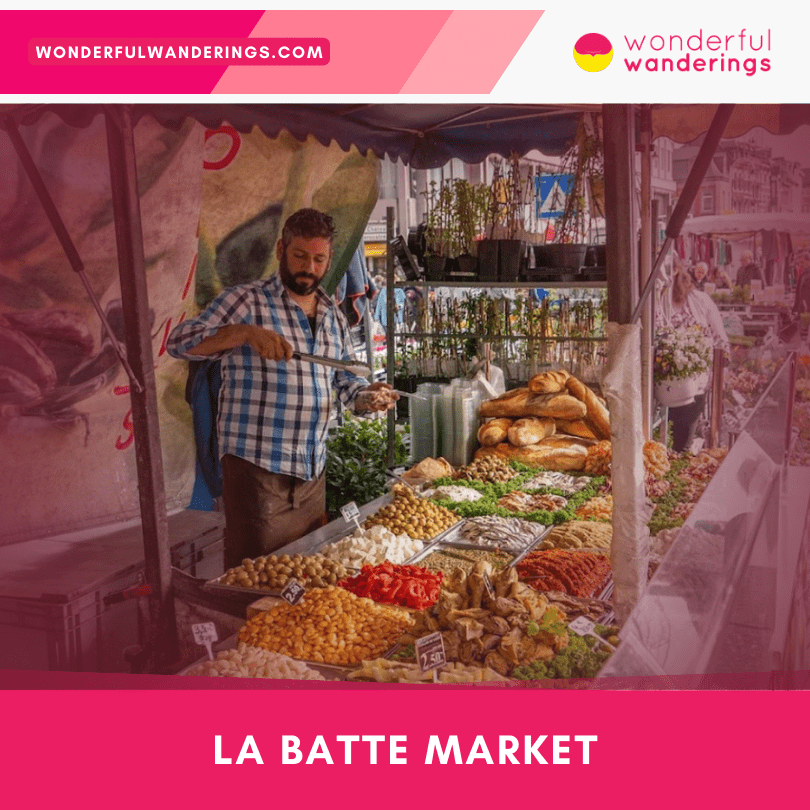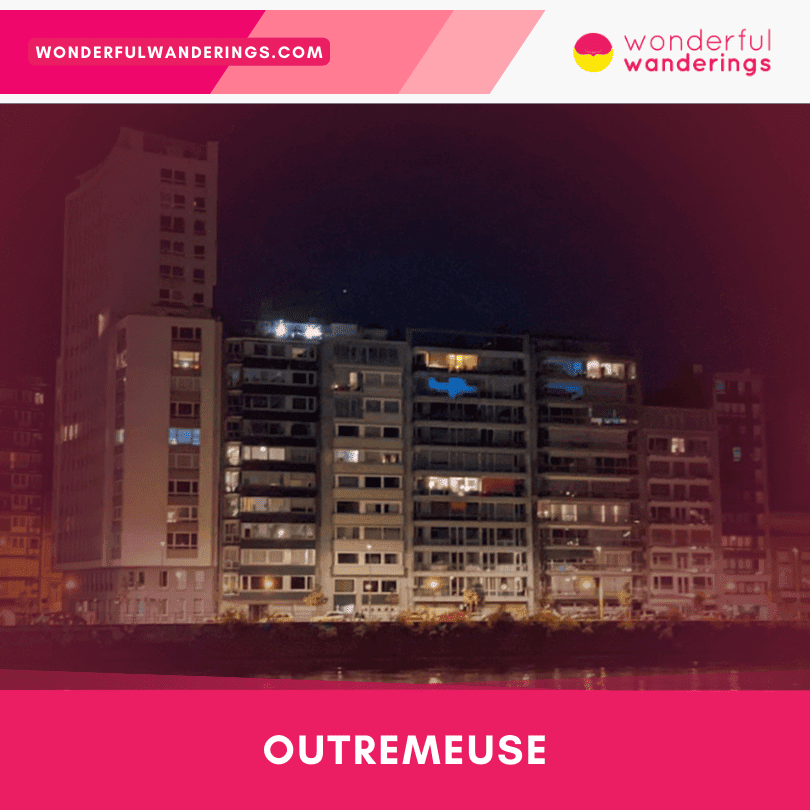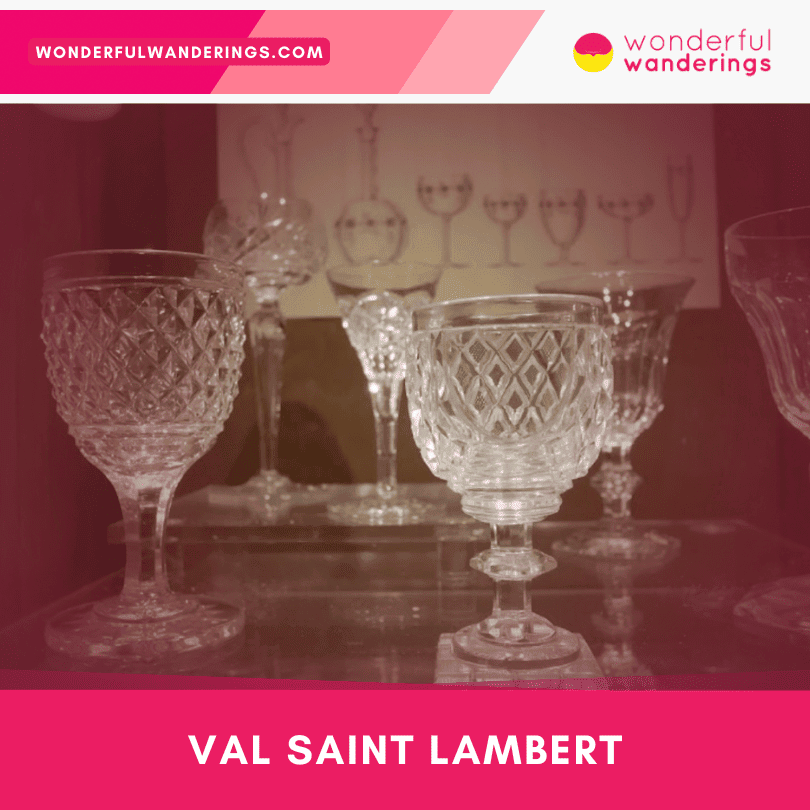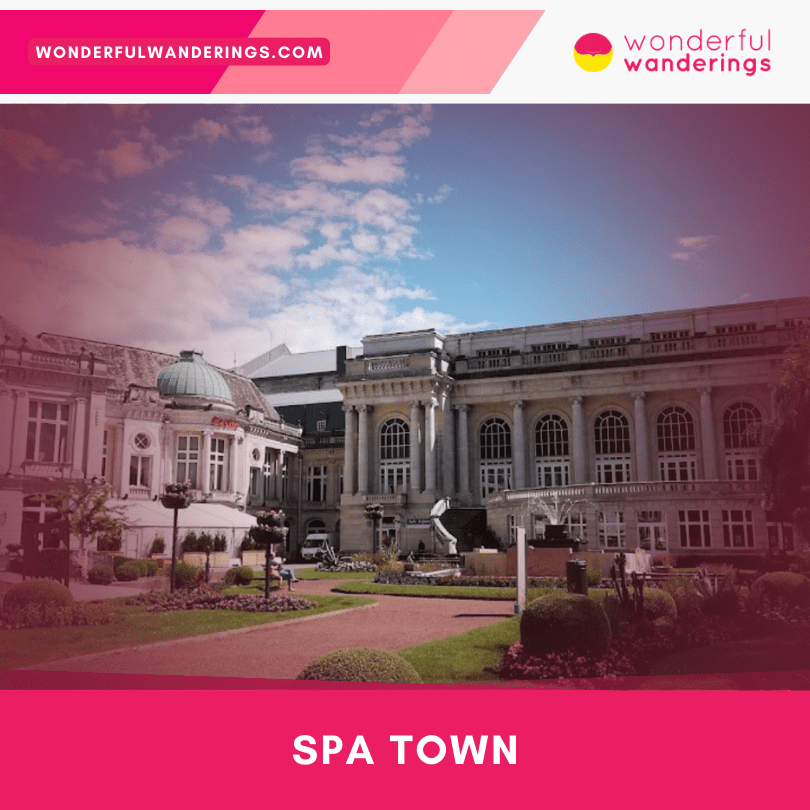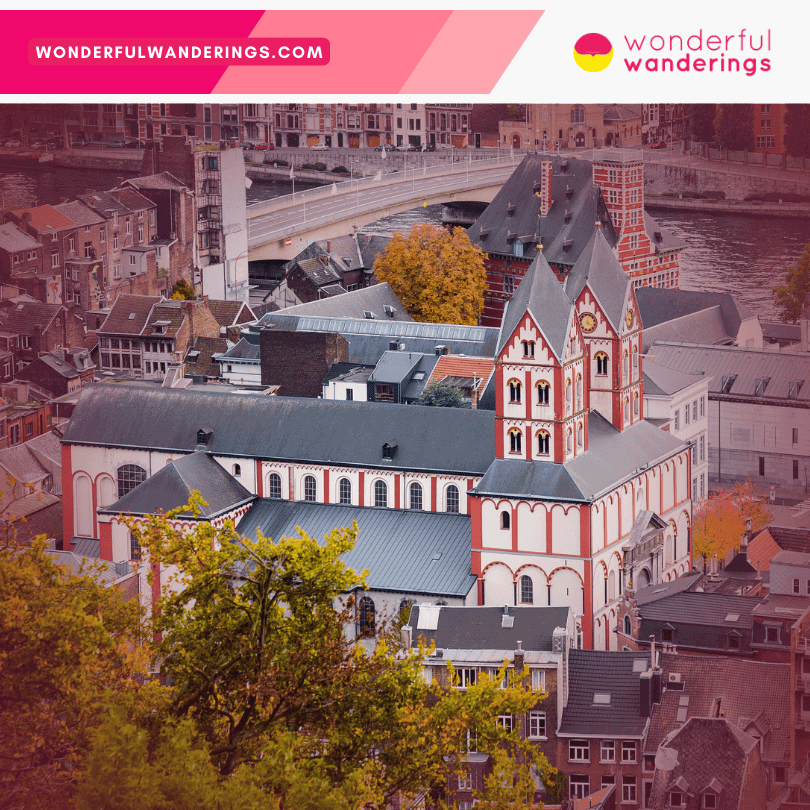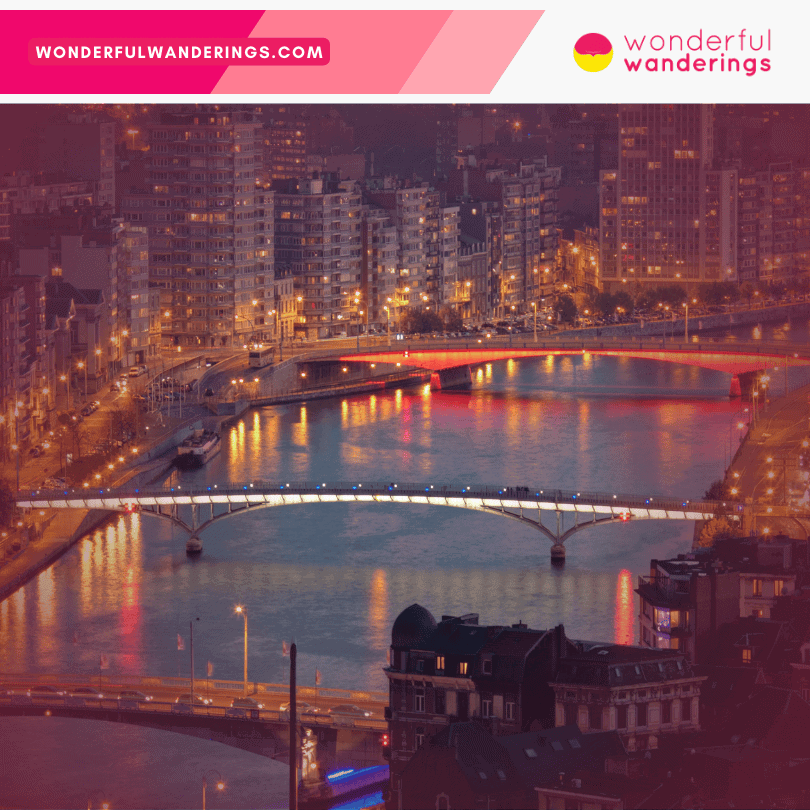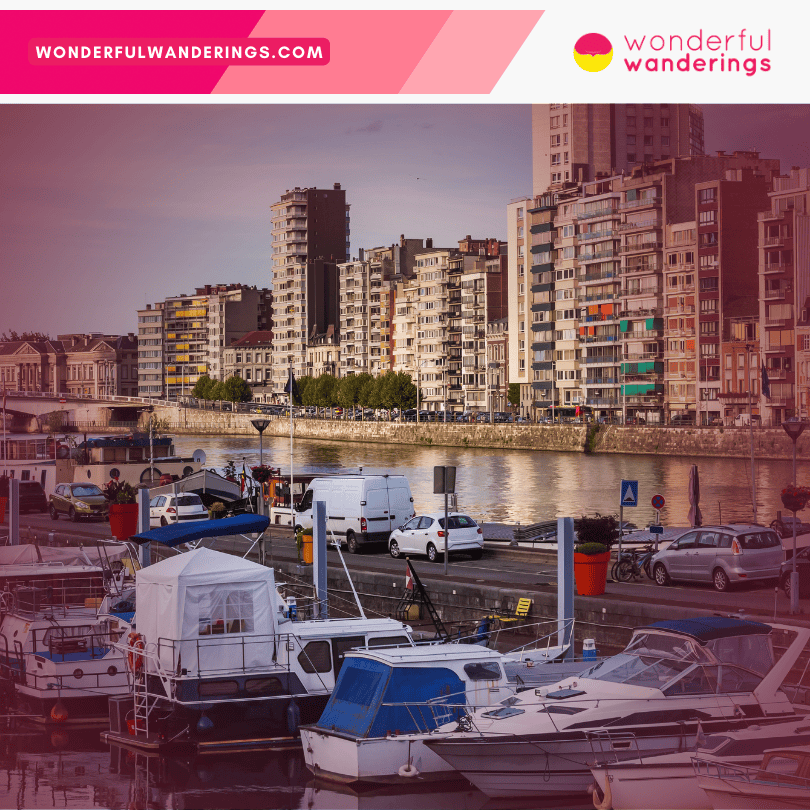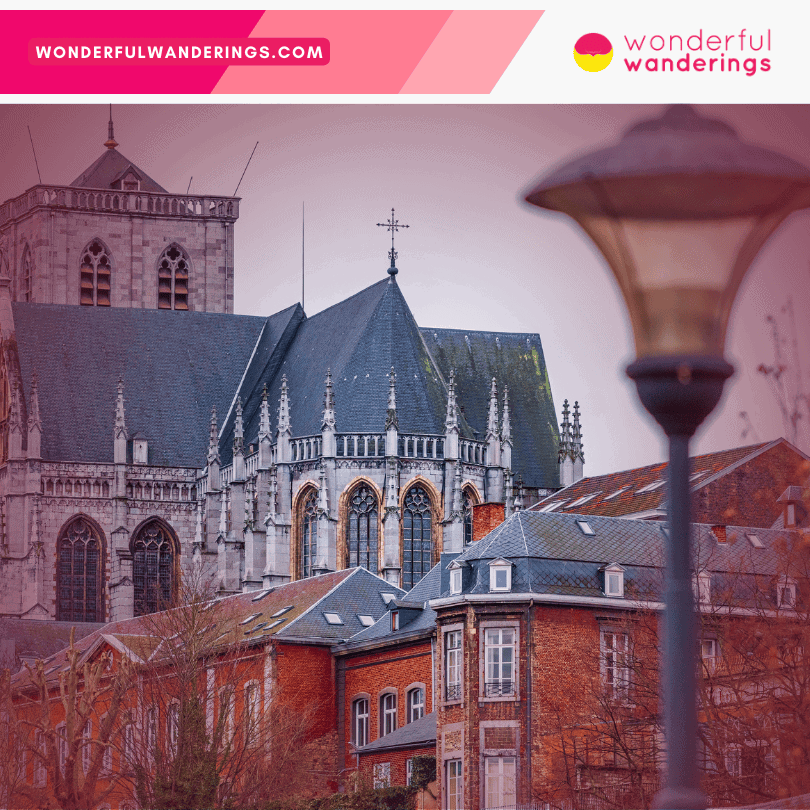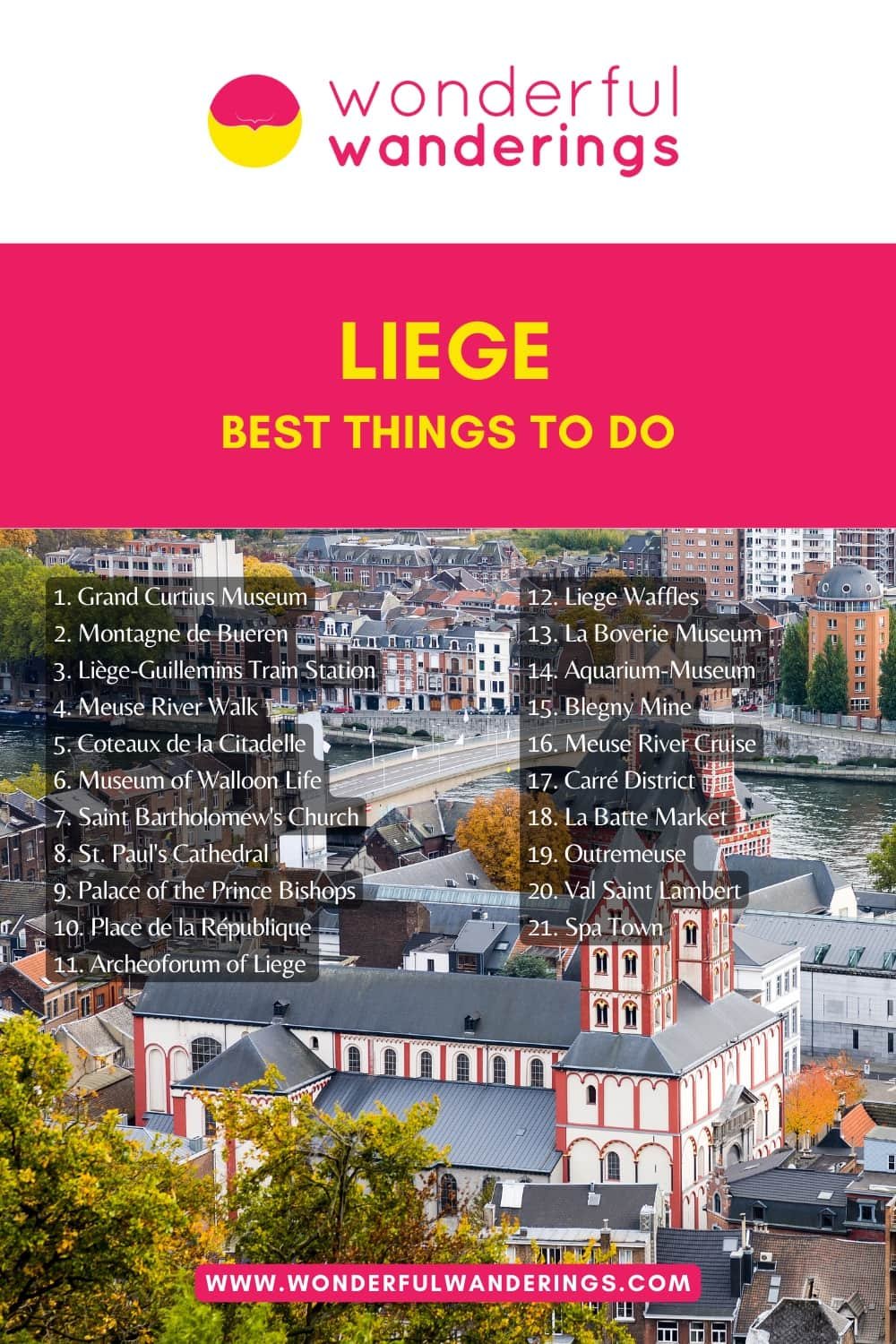Liege, a capital city in the Wallonia region of Belgium, is located alongside the Meuse River, in Belgium. Liege has grown to become a hub with a rich industrial legacy. Liege is not just a relic of the past; it actively embraces the future, as evident from its modern infrastructure like the Liège-Guillemins Railway Station, which links Liege to other major Belgian cities, serving as a gateway for many travelers.
After you explore the 21 amazing things to do in Liege, you’ll find that the city offers an intriguing mix of historical richness and modern-day amenities, making it a must-visit on any Belgian itinerary.
Contents
- 1. Visit the Grand Curtius Museum
- 2. Climb the Montagne de Bueren
- 3. See the Liège-Guillemins Train Station
- 4. Walk along the Meuse River
- 5. Explore the Coteaux de la Citadelle
- 6. Tour the Museum of Walloon Life
- 7. See Saint Bartholomew’s Church
- 8. Visit St. Paul’s Cathedral
- 9. Go to the Palace of the Prince Bishops
- 10. Take in the architecture at Place de la République
- 11. See the Archeoforum of Liege
- 12. Eat a Liege Waffle
- 13. Discover the Treasures at La Boverie Museum
- 14. Explore the Marine Life at Aquarium-Museum
- 15. Journey Into the Past at Blegny Mine
- 16. Cruise the Meuse River on a Boat Tour
- 17. Experience the Nightlife in Le Carré District
- 18. Shop Local Goods at La Batte Market
- 19. Wander Through Historic Outremeuse
- 20. Visit Val Saint Lambert
- 21. Day trip to Spa Town
- What are the best museums to visit in Liège?
- What are the best things to do in Liege with kids and toddlers?
- What are the top things to do in Liege when in town for business?
- What to do in Liege for a day?
- Where is Liege?
- What is the history of Liege?
- How many people live in Liege?
- What should somebody know before visiting Liege?
- Is it worth visiting Liege?
- When is the best time to visit Liege?
- How many days are enough to see Liege?
- What to eat in Liege?
- What are the best restaurants in Liege?
- Which area is the best areas to stay in Liege as a tourist?
- What are the best hotels in Liege?
- Is there a Christmas Market in Liege?
- What are the best Christmas markets in Belgium?
- What are the best music festivals in Belgium?
Listed below are the best things to do in Liege.
- Visit the Grand Curtius Museum. The Grand Curtius Museum is an art and history museum located in Liège, Belgium. Spread over 5000 square meters, it contains over 5200 artifacts, with some pieces dating back 7000 years. The museum is housed in an architectural complex structured around beautiful inner courtyards. Highlights include the museum’s extensive collections of arms and weaponry, glassware, religious art and Mosan art. The Grand Curtius can be appreciated for its world-class collections and exhibits that cover various aspects of Liège’s long history, economy, agriculture, folklore, traditions, religious beliefs, arts, and daily life over the past two millennia.
- Climb the Montagne de Bueren. The Montagne de Bueren is a 374-step staircase located in Liège, Belgium. With an upward climb of 70 meters involving a 30% incline, it is considered one of the most extreme staircases in the world. The staircase was built in 1881 to provide direct access between the city center and the citadel atop the hill where soldiers were stationed. Climbing to the top is a formidable feat requiring stamina and determination. The scenic panoramic views of Liège at the top make the arduous journey worthwhile. Many people time themselves running up the stairs as a fitness challenge.
- See the Liège-Guillemins Train Station. The Liège-Guillemins Train Station is a stunning piece of modern architecture designed by Spanish architect Santiago Calatrava. The station was rebuilt between 1999-2009 to accommodate high-speed rail travel. Calatrava designed an impressive steel and glass railway station that looks like an enormous curved rib cage arching over the tracks. The monumental vaulted roof seems to float effortlessly over the platforms below. The transparent design unites the railway hub with the surrounding cityscape.
- Walk along the Meuse River. The Meuse River flows through France, Belgium, and the Netherlands for 575 miles before reaching the North Sea. The river has carved out a picturesque landscape that draws many visitors today. Along the Meuse, opportunities abound for recreation like cycling, boating, fishing and kayaking on calm stretches of the river. The Meuse valley between Dinant and Namur in Belgium offers stunning river views between towering limestone cliffs. The river appeals to nature lovers, history enthusiasts, and outdoor adventurers alike.
- Explore the Coteaux de la Citadelle. The Coteaux de la Citadelle is a lush 90 hectare green space in central Liège, Belgium. It provides 13 kilometers of hiking trails and over 60 historic sites and monuments within its grounds. Highlights include the ruins of a 13th century abbey, the imposing 374-step Montagne de Bueren staircase, and scenic viewpoints overlooking the city. Five color-coded walking loops ranging from 45 minutes to 2 hours allow visitors to explore the various areas and attractions. Wandering the trails is an excellent no-cost activity to take in city views, appreciate nature and get exercise.
- Tour the Museum of Walloon Life. The Museum of Walloon Life depicts the history and culture of Wallonia and its people from the 19th century to the present day. It is housed in a former 13th century Franciscan monastery in Liège. The museum has over 100,000 artifacts and exhibits covering various aspects of Wallonian life including economy, agriculture, folklore, traditions, religious beliefs, arts, and daily life. Highlights include exhibits on the famous Liège puppets, literature and folklore, a reproduction of a 19th century Walloon mine, and displays on crafts like lacemaking.
- See Saint Bartholomew’s Church. Saint Bartholomew’s Church is an 11th century Roman Catholic collegiate church situated in Liège, Belgium. It retains its Romanesque architectural style despite modifications over the centuries. The church houses numerous notable artworks and treasures, being an important example of Mosan art. It is most renowned for housing the 12th century baptismal font crafted by Renier de Huy, considered a masterpiece of medieval Mosan art and one of Belgium’s “Seven Wonders”.
- Visit St. Paul’s Cathedral. St. Paul’s Cathedral is a Gothic-style cathedral located in the heart of Liège, Belgium. With roots dating back to the 10th century, the current cathedral was constructed between the 13th and 15th centuries. Visitors can admire the immense interior, soaring ceilings, intricate stonework, and elaborate stained glass windows. Highlights include the 16th century frescoes on the ceiling, a 14th century jewel-encrusted reliquary, and marble sculptures by renowned artists like Jean Del Cour. The cathedral houses valuable artworks and provides a glimpse into Liège’s past prominence in medieval Europe.
- Go to the Palace of the Prince Bishops. The Palace of the Prince Bishops in Liège was the former residence and seat of power of the Prince-Bishops of Liège who ruled the independent Prince-Bishopric of Liège from 980 AD until 1795. Destroyed by fires and rebuilt multiple times over the centuries, the current palace façade dates to the 18th century. Today, the palace houses both the provincial government of Liège and the Palace of Justice. The ornate interior courtyard with columns featuring grotesque carvings is open to the public and showcases the palace’s Renaissance architecture.
- Take in the architecture at Place de la République. Place de la République is a major public square surrounded by historic buildings in central Liège. The rectangular-shaped square contains landmarks like the 16th century Hôtel de Ville de Liège and is situated near the Prince-Bishops’ Palace and Church of Saint-Jean-Baptiste. With its central location, the square hosts many cultural events, festivals, markets and demonstrations throughout the year. Visitors can admire the square’s Flemish Renaissance-style buildings and discover monuments like the statue of Grétry and the Paris Fountain while enjoying the vibrant ambiance.
1. Visit the Grand Curtius Museum
The Grand Curtius Museum is an art and history museum located in the heart of Liège, Belgium. Sitting on the banks of the Meuse River, this impressive museum complex houses the collections of four former museums, including archeology, weaponry, decorative arts, and religious and Mosan art. Spread over 5000 square meters, the Grand Curtius contains over 5200 artifacts, with some pieces dating back 7000 years.
The museum is housed in an architectural complex structured around beautiful inner courtyards. The Curtius Palace, built in the early 1600s for Jean de Corte, an arms dealer known as Curtius, is the most iconic building on the site. Its distinctive red brick and mascaron stonework mark it as an excellent example of the Mosan Renaissance style.
The Grand Curtius is sometimes referred to as the Curtius Museum, after its original resident Jean Curtius. However, since its reopening in 2009 after an extensive renovation, it is now more commonly called the Grand Curtius.
What makes the Grand Curtius Museum special is its world-class collections. The museum has one of the most extensive collections of arms and weaponry globally, with around 600 pieces on display. There are intricate swords, pistols, rifles, armor, and cannons crafted by Liège’s master metalworkers since the 16th century.
The museum also houses an internationally recognized glass collection numbering 10000 pieces. It includes ancient Egyptian and Roman glass, Venetian and facon de Venise glassware, Art Nouveau works, and 20th century Art Deco and Scandinavian pieces.
Other highlights are the religious art and Mosan art collections with metalwork, sculpture, furniture, and illuminated manuscripts. Some notable works are the 12th century Sainte-Croix triptych, the 10th century Evangelarium of Notger, and Jean Del Cour sculptures.
Visitors to the Grand Curtius can explore the different collections through two thematic tours. There are chronological displays tracing the history of Liège, exhibits on social history and decorative arts, plus arts and artifacts from other cultures. Visitors can also enjoy the temporary exhibitions held at the museum.
The Grand Curtius is located right in the heart of Liège at Quai de Maastricht 13, 4000 Liège. It sits beside the Meuse River, close to the Guillemins train station. Visitors can take public transport to Liège, then walk 10 minutes to the museum. There is some parking nearby too.
The museum appeals most to adults interested in art, history and culture. However, the collections and exhibits also cater well to families. Children can enjoy exploring the museum and spotting interesting artifacts.
Entry to the permanent collections at the Grand Curtius costs €9 (US$9.50, £7.70) for adults, €5 (US$5.30, £4.30) for seniors and is free for under 26s. Special exhibition tickets cost extra. The museum offers free admission on the first Sunday of each month.
2. Climb the Montagne de Bueren
Montagne de Bueren is a 374-step staircase located in the heart of Liège, Belgium. With an upward climb of 70 meters involving a 30% incline, it is considered one of the most extreme staircases in the world. The staircase was built in 1881 to provide direct access between the city center and the citadel atop the hill where soldiers were stationed. It is named after Vincent de Bueren, a 15th century hero who led the city’s defense against an attack by Charles the Bold, Duke of Burgundy.
The staircase is located at Montagne de Bueren 33, 4000 Liège, Belgium. It is sometimes referred to as the “600 escaliers” in reference to the 600 soldiers led by Vincent de Bueren who died defending the city. The steps is rising over 70 vertical meters, so climbing to the top is a formidable feat requiring stamina and determination. The staircase presents a thrilling physical challenge for fitness enthusiasts and adrenaline seekers. For history buffs, it offers the opportunity to follow in the footsteps of medieval soldiers who climbed these same stairs. The rewarding panoramic views of Liège at the top also make the arduous journey worthwhile.
Visitors can climb the stairs, take photos on the steps, enjoy the scenic city views from the top, explore the architecture of the staircase, and learn about its history. Many people time themselves running up the stairs as a fitness challenge. The Nocturne des Coteaux festival in October sees the staircase decorated with thousands of candles, creating a magical illuminated display at night. During the June flower festival, the stairs are adorned with over 20,000 colorful blooms.
The best way to reach the staircase is on foot, as it sits right in the heart of Liège’s pedestrian old town. The nearest metro station is Liege-Palais, just a short 5-10 minute walk away. Parking garages can also be found within a 10 minute walking distance.
Climbing the Montagne de Bueren is suitable for most ages and fitness levels. There are periodic landings with benches to rest along the way. The lower sets of stairs are quite wide. Narrower steps higher up may be tricky for those with limited mobility. Parents should closely supervise children. Comfortable shoes with good grip are recommended.
The staircase is freely accessible with no admission cost. It can be visited at any time as it is outdoors in a public space. Morning and evening tend to be the coolest times in summer.
3. See the Liège-Guillemins Train Station
The Liège-Guillemins Train Station is a stunning piece of modern architecture and a major transportation hub located in Liège, Belgium. With its impressive steel and glass canopy designed by Spanish architect Santiago Calatrava, the train station has become an iconic landmark and source of pride for the city of Liège.
The Liège-Guillemins Train Station is located at Place des Guillemins 2, 4000 Liège, Belgium. It sits just south of the city center, about 2 kilometers away. The main station lies on the major rail line connecting Brussels to Germany, making Liège-Guillemins one of Belgium’s most important railway stations. It is one of only four Belgian stations on the high-speed rail network.
This train station is also sometimes referred to as Liege-Guillemins Railway Station or Gare de Liege-Guillemins. The station’s official name combines the neighborhood of Guillemins where it is situated and the French spelling of the city Liege.
What makes the Liège-Guillemins Train Station so special is its incredible architecture. The station was rebuilt completely between 1999 and 2009 to accommodate high-speed rail travel. Santiago Calatrava was commissioned to design an entirely new station to replace the outdated existing structure. He created a soaring steel and glass railway station that looks like an enormous curved rib cage arching over the tracks. The jewel of the station is the monumental vaulted roof, 200 meters long and 32 meters high. It seems to float effortlessly over the platforms below. The transparent and airy design unites the railway hub with the surrounding cityscape.
Inside, the Liège-Guillemins Train Station contains many services for travelers. At the ground floor entrance level are shops, restaurants, ticket counters and waiting areas. Escalators and elevators provide access to the five platforms above. An underground passage beneath the tracks connects one side of the station to the other, improving permeability between neighborhoods previously divided by the rail line. The station also adjoins a large parking garage and bus terminal for easy transfers.
Visitors to the Liège-Guillemins Train Station can simply admire the architecture and take photos of the impressive steel and glass canopy above. The station is fully open to the public 24 hours a day since it is an active transportation hub. Visitors can watch trains come and go from the many comfortable seating areas. There are also shops and eateries to browse.
The best way for tourists to reach the Liège-Guillemins Train Station is by train, bus or taxi. The station is connected to Liège’s city bus network, with stops just outside. Taxis can drop off passengers directly at the station entrance. Travelers coming from other Belgian cities can take direct trains to Liège-Guillemins. The station is on the main rail line linking Brussels, Leuven, Namur and Luxembourg. High-speed Thalys and ICE trains also stop here, providing quick connections to Paris, Cologne and Frankfurt.
Visiting the Liège-Guillemins Train Station is suitable for all audiences. Train lovers and architecture aficionados will especially appreciate the chance to see Calatrava’s design in person. But the striking building has visual appeal for anyone, including families and children. There is no admission fee to enter the station and view the architecture. Train tickets must be purchased separately to board the trains.
4. Walk along the Meuse River
The Meuse River flows through France, Belgium, and the Netherlands. Originating in France, it travels roughly 575 miles before reaching the North Sea. The Meuse passes through major cities like Liege, Belgium and Maastricht, Netherlands. This vital waterway has played an integral role in the region’s development and culture throughout history.
The Meuse River offers diverse recreational opportunities. Visitors can walk along scenic riverside trails, cycle on designated paths, or explore historic sites located along the banks. Boating, fishing, picnicking, and wildlife viewing are other popular activities. The river also hosts festivals and events in riverside communities. From urban Liege to the pastoral countryside, the Meuse provides a unique way to experience the culture and nature of northwest Europe.
As an inland waterway, the Meuse has long served as an important transportation route. Narrow in parts but navigable for hundreds of miles, it facilitated trade and movement of goods between medieval cities and across borders. Today, commercial barges still utilize the Meuse for shipping bulk cargo. The river and its banks are dotted with historic ports, locks, and warehouses that attest to its enduring legacy as a conduit for commerce.
The Meuse River valley provides a window into the region’s distant past. Limestone cliffs lining the river have allowed valuable archaeological excavations at sites like the Neanderthal caves near Dinant, Belgium. The Meuse’s role as a natural border shaped medieval powers and kingdoms. Castles and fortresses overlooking the river acted as strategic strongholds for rulers in centuries of conflict. Even in modern times, the Meuse figured critically in the World Wars as armies jockeyed to control its crossings.
With sources high in the Ardennes Forest, the Meuse swells with snowmelt and rainfall, historically causing destructive flooding in watershed cities and towns. Flood protection is an enormous challenge today. Dams, dikes, and diversion channels attempt to regulate its flows and minimize risk to riverside communities. Maintaining the Meuse’s floodplain habitats is crucial for Wildlife as well.
The Meuse has inspired art and culture celebrating its picturesque landscapes. Mosan art flourished in the Meuse valley around medieval Liege and Maastricht, leaving a rich artistic legacy. Letters and literature make frequent allegorical references to the river as a life source traversing the region’s geography and history.
Free-flowing in places but harnessed for transportation and commerce, the Meuse River persists as a living thread stitching northwest Europe together via nature, culture, and trade. It remains an essential artery for commerce and provides a bounty of recreational opportunities in the heart of Europe.
5. Explore the Coteaux de la Citadelle
The Coteaux de la Citadelle is a lush green space spanning over 90 hectares right in the heart of Liège, Belgium. It is located between the Meuse River and the remains of the old citadel fortress, which gives the area its name. Though situated in the city center, the Coteaux de la Citadelle feels like an unexpected countryside escape with its rolling hills and dense tree cover. It provides around 13 kilometers of marked hiking trails to explore, along with over 60 historic sites and monuments within its grounds.
The Coteaux de la Citadelle showcases both the natural and cultural heritage of Liège. Along the walking paths, you’ll find meadows, orchards, forests, parks, gardens and some remaining vineyards. Over 40 hectares are protected as a site of high biological importance, providing habitat for 90+ animal species including 16 rare and threatened ones. The grounds also contain an array of landmarks testifying to Liège’s long history – remnants of medieval walls, religious foundations, coal mining infrastructure, fortifications and more. Highlights include the ruins of a 13th century abbey, the imposing 374-step Montagne de Bueren staircase, and scenic viewpoints overlooking the city.
There are five color-coded walking loops ranging from 45 minutes to almost 2 hours that allow visitors to explore the various areas and attractions within the Coteaux de la Citadelle. Maps can be picked up for free at the Liège tourism office. Wandering the trails is an excellent no-cost activity to take in city views, appreciate nature and get exercise. Locals often come to jog, walk dogs, picnic or relax in the fresh air.
The Coteaux de la Citadelle covers several central Liège neighborhoods including Pierreuse, Féronstrée and Hors-Château. It is accessible via the “La Belle Liégeoise” pedestrian bridge near Fragnée or at the base of the Montagne de Bueren steps. Public transportation options include bus lines 12, 19, 24, 53, 61, 70, 71, 72, 73, 74, 75, 81, 82, 83, 84, 85, 88, 90, 94 and 175 to the Saint Lambert Terminal stop.
The Coteaux de la Citadelle is best explored on foot with sturdy shoes, due to the hilly topography. The grounds are open daily from dawn to dusk, and can be enjoyed by visitors of all ages seeking an outdoor reprieve from the city. Admission is free. By intermixing important landmarks and beautiful nature, the Coteaux de la Citadelle offers a unique hybrid experience. Within its boundaries, you can admire Liège’s layered history and heritage while also finding wilderness and fresh air. This distinctive urban oasis reveals new sides of the city for locals and travelers alike.
6. Tour the Museum of Walloon Life
The Museum of Walloon Life is a museum located in Liège, Belgium that depicts the history and culture of Wallonia and its people from the 19th century to the present day. It is housed in a former 13th century Franciscan monastery called the Cour des Mineurs, which provides a beautiful setting for the museum. The Museum of Walloon Life is also sometimes known as the Musée de la Vie wallonne.
What makes the Museum of Walloon Life special is its extensive and diverse collections and exhibits that cover various aspects of Wallonian life over the past two centuries. The museum has over 100,000 artifacts in its collection, including folk art, puppets, industrial and agricultural objects, manuscripts, paintings, sculptures, and more. Through these collections, visitors can learn about the region’s economy, agriculture, folklore, traditions, religious beliefs, arts, and daily life.
The museum features both permanent and temporary exhibitions in an innovative scenography that combines ancient and modern elements. The permanent exhibits depict Wallonian society, beliefs, traditions, arts, and crafts through five different themes. Visitors can explore rooms decorated with artifacts, documents, sounds, videos, and images that bring history to life. There are also many interactive elements, games, and hands-on activities.
Some of the highlights at the Museum of Walloon Life include the exhibit on the famous Liège puppets and puppetry, the sections on literature and folklore, a reproduction of a 19th century Walloon mine, and displays on crafts like lacemaking. The museum also has an extensive documentation center and library in the historic Chamart house next door.
Visitors to the Museum of Walloon Life can take part in guided tours, educational activities for kids, workshops, lectures, concerts, and special events. The tours and activities are available in several languages including French, English, German, Dutch, and Italian. There is also a museum shop and restaurant on site.
The Museum of Walloon Life can be easily accessed by public transportation, located in the heart of Liège city center. It is about a 10 minute walk from the Liège-Palais train station. The full address is Cour des Mineurs 4000 Liège, Belgium.
The museum appeals to visitors of all ages and backgrounds who want to learn about Wallonia’s local history and cultural heritage. It is especially enjoyable for those interested in art, history, anthropology, and social traditions. Families will appreciate the hands-on exhibits and activities for kids. There is no admission fee for the permanent collections, making it an affordable attraction.
7. See Saint Bartholomew’s Church
Saint Bartholomew’s Church is an 11th century Roman Catholic collegiate church situated in Liège, Belgium. It was founded outside the medieval city walls and retains its Romanesque architectural style despite modifications over the centuries. The church has distinctive cream and red brick walls, grey slate roof, and two towers in Ottonian design.
Saint Bartholomew’s Church is an impressive 11th century church constructed with coal sandstone between the late 11th and 12th centuries. The interior showcases the original medieval Romanesque architecture after recent renovations removed later additions. The church houses numerous notable artworks and treasures, being an important example of Mosan art.
The address of Saint Bartholomew’s Church is Place Saint-Barthélemy 8, 4000 Liège, Belgium. The church is located in the heart of historic Liège, near the Meuse River and landmarks like the Grand Curtius Museum.
The church is alternatively known as the Collegiale Saint-Barthélemy in French, or Sint-Bartolomeüskerk in Dutch.
Saint Bartholomew’s is most renowned for housing the 12th century baptismal font crafted by the metalworker Renier de Huy in Romanesque style. The impressive brass font depicts Biblical baptism scenes and is considered a masterpiece of medieval Mosan art. It is one of Belgium’s “Seven Wonders.” Other notable artworks are by Bertholet Flemalle and Englebert Fisen, plus the famed 17th century carillon from Val-Saint-Lambert Abbey.
Visitors can admire the architecture, art and famous baptismal font at Saint Bartholomew’s Church. Guided tours of the historic church are available. Concerts may also be performed on the antique carillon and organ. There is a small admission fee to enter and view the font.
The church can be easily accessed by public transport, as it is near the Liège-Palais train station. Limited parking is available nearby. Liege is around 2 hours by train from Brussels. The church is centrally located and walkable from hotels in Liège’s city center.
Saint Bartholomew’s appeals to visitors interested in Romanesque buildings, medieval art and Belgian heritage. Adults and older children with an appreciation of history and art would find it most engaging. Religious visitors also frequent the active church.
The entrance fee for adults is 3 euros (US$3.4, £2.7), 2 euros (US$2.2, £1.8) for seniors, and 0.75 euros (US$0.84, £0.68) for students. Children under 12 years enter at no cost. Additional fees may apply for guided tours and concert events.
8. Visit St. Paul’s Cathedral
St. Paul’s Cathedral is a Roman Catholic cathedral located in the heart of Liège, Belgium. With roots dating back to the 10th century, the current Gothic-style cathedral was constructed between the 13th and 15th centuries, though it has undergone restoration and renovation over the years. Sometimes referred to as Cathédrale Saint-Paul de Liège, St. Paul’s Cathedral serves as the seat of the Bishop of Liège and is known for its impressive architecture, its treasury of religious artifacts and art, and its history as one of the only buildings to survive the destructive fires that swept Liège in the 18th century.
Visitors to St. Paul’s Cathedral can expect to be awed by the immense interior, which features soaring ceilings, intricate stonework, and elaborate stained glass windows that fill the space with colorful light. The cathedral is approximately 84 meters long, 34 meters wide, and 24 meters tall, providing a grand sense of scale. One of the most stunning aspects is the ceiling, which is painted with 16th century frescoes that remain vividly preserved. The cathedral also contains many valuable artworks, such as an ornate bust reliquary of Saint Lambert that dates back to the early 16th century and holds a fragment of the saint’s skull.
In the treasury, visitors can admire precious relics like a jewel-encrusted 14th century reliquary known as the Reliquary of Charles the Bold, as well as ornate textiles, carved ivories, and more. The cathedral is also home to sculptures by renowned artists like Jean Del Cour, including his famous marble sculpture of the dead Christ, known as Christ Gisant. Another unique sculpture is the Lucifer of Liège, which depicts the fallen angel Lucifer chained yet beautiful, installed in 1848 within the niche of the pulpit stairs.
Guests can explore on their own, admiring the architecture and artworks at their own pace, or take a guided tour for insight into the cathedral’s rich history. The cloister adjacent to the cathedral contains tombstones of former prince-bishops of Liège and is a peaceful spot to walk through. In addition to self-guided visits, the cathedral often hosts concerts, especially of sacred music using the grand pipe organ within the cathedral.
St. Paul’s Cathedral is located on the Place de la Cathédrale in the heart of Liège, Belgium. The address is Place de la Cathédrale 1, 4000 Liège. The city of Liège can be reached by car, train, or plane, with the nearest international airport being Brussels Airport, about 90 kilometers (56 miles) away. High-speed trains connect Brussels to Liège in just over an hour. The cathedral sits in the historic city center of Liege within walking distance of the central train station of Liège-Guillemins.
Visiting the cathedral is free, allowing guests of all ages and interests to enjoy this architectural and artistic wonder. The hours are 8:00AM to 5:00PM daily. Special activities like concerts have a fee. Guided tours are available for groups by prior reservation. Entrance to the treasury has an admission fee of approximately 5 € ($5.50, £4.60). St. Paul’s Cathedral attracts visitors interested in Gothic architecture, art lovers eager to see sculptures and relics, and anyone curious about Belgian and Catholic history.
9. Go to the Palace of the Prince Bishops
The Palace of the Prince Bishops is a historic building located in the heart of Liège, Belgium on Place Saint-Lambert. It was the former residence and seat of power of the Prince-Bishops of Liège who ruled the independent Prince-Bishopric of Liège from 980 AD until 1795. The palace has a long and turbulent history, having been destroyed by fire and rebuilt multiple times over the centuries.
The original palace on the site was built around 1000 AD under Prince-Bishop Notger but was destroyed in a fire in 1185. It was rebuilt in the late 12th century in a Romanesque style but was heavily damaged in 1468 when Liège was sacked by Burgundian troops. In the early 16th century, Prince-Bishop Erard de La Marck commissioned the palace to be rebuilt in a late Gothic style with some Renaissance influences. The architect for this version was Arnold van Mulcken. The principal south facade overlooking Place Saint-Lambert was reconstructed in 1734-1735 in the French Regency style after another destructive fire, under the direction of Brussels architect Jean-André Anneessens. The final expansion occurred in 1849 when a new west wing facing the Meuse River was added by architect Jean-Charles Delsaux to accommodate the provincial government.
Today, the Palace of the Prince Bishops is still an important administrative center, housing both the provincial government of Liège and the Palace of Justice where the city’s law courts are located. The palace’s interior courtyard is open to the public and showcases the Renaissance architecture for which the building is renowned. The colonnaded courtyard has 60 columns, each topped by a capital featuring unique grotesque carvings with fanciful masks and figures, some inspired by discoveries from the New World.
The palace was once situated directly adjacent to the enormous Gothic Cathedral of Saint Lambert, which was the seat of the Prince-Bishops. However, the cathedral was destroyed in the late 18th century by anti-clerical French revolutionary forces. Its foundations can be viewed in the Archeoforum museum located just behind the palace.
Visitors to Liège can view the exterior facade of the Palace of the Prince Bishops from the expansive Saint Lambert Square, as well as explore the ornate interior courtyard which is open to the public. The courtyard and exterior can be appreciated by people of all ages. There is no admission fee to see the courtyard. Guided tours may be available through the tourist information office for a small fee.
The Palace of the Prince Bishops holds great historical significance as the epicenter of secular and religious power in Liège for over 800 years when the city was the capital of an independent prince-bishopric state within the Holy Roman Empire. While the palace may lack interior tours, its imposing architecture and the accessible courtyard give a glimpse into Liège’s past prominence as ruled by the prince-bishops.
10. Take in the architecture at Place de la République
Place de la République is a major square located in the heart of the city of Liège, Belgium. With an area of around 5,079 square meters, it is one of the largest public squares in Liège. The rectangular-shaped square is surrounded by historic buildings, including the Liège City Hall, the Prince-Bishops’ Palace, and the Church of Saint-Jean-Baptiste.
The square is situated in central Liège, with the full address being Place de la République Française, 4000 Liège, Belgium. It can also be referred to as Place de la République Française.
Place de la République was originally called “Place aux Chevaux” in the 13th century and later gone through numerous name changes over the centuries. In 1818, it was renamed Place de la Comédie, followed by Place du Spectacle and Place du Théâtre. It finally acquired its current name, Place de la République Française, in 1918 after World War I to honor the French Republic. Given its central location, the square hosts many cultural events, festivals, markets and demonstrations throughout the year. During summer months, the square comes alive with outdoor evening concerts, dining terraces and a vibrant atmosphere.
For visitors, Place de la République offers plenty of sightseeing opportunities. People can admire the square’s Flemish Renaissance-style buildings, including the 16th century Hôtel de Ville de Liège. Walking around the square leads to discoveries of monuments like the statue of Grétry and the Paris Fountain. Visitors can also do some shopping at the commercial buildings lined with shops and boutiques.
The square is easily accessible by public transportation, located just steps away from Liège-Palais train station. City buses 1, 25, 26, 29, 31, 33 and 35 have a stop at Place de la République. Driving to the square is also convenient with main roads like Boulevard de la Sauvenière leading directly to it.
With its central location and abundance of cafés, bars and restaurants, Place de la République makes an ideal spot for people watching and soaking up the local Liège culture. Families will appreciate the play areas for children. Its vibrant ambiance also appeals to couples, friends and solo travelers who want to experience an authentic Liège hangout.
Since the square is situated in the pedestrian zone of the city center, there is no admission cost to enter. Visitors can freely walk around and access all the sites and amenities available at Place de la République. The only costs incurred would be for food, drinks or shopping at the restaurants and boutiques surrounding the square.
11. See the Archeoforum of Liege
Archeoforum of Liege is an archaeological museum located underneath Place Saint-Lambert in the heart of Liège, Belgium. Covering an area of 3,725 m2, it is one of the largest underground urban archaeological sites in Europe. The museum presents the history of Liège from prehistoric times to the present day through both movable and immovable archaeological remains. Visitors can see the foundations of the former Saint Lambert Cathedral, the remains of an ancient Gallo-Roman villa, and traces of prehistoric settlements.
The address of Archeoforum of Liege is Place Saint-Lambert, 4000 Liège, Belgium. It is sometimes referred to as Archéoforum de Liège in French.
What makes Archeoforum of Liege special is its sheer size and the way it brings history to life by allowing visitors to walk through archaeological ruins dating back thousands of years. The remains on display provide a fascinating glimpse into Liège’s past as an important city in medieval Europe. Seeing the cathedral foundations and villa ruins up close creates a vivid impression of daily life during those eras.
At Archeoforum of Liege, visitors can take an audio tour using provided tablets or book a guided tour. The audio tour features extra content like interviews and 3D models, while the guided tour allows for more in-depth explanations from a knowledgeable archaeology enthusiast. Tours typically take 1-2 hours depending on the level of detail desired. There are interactive features for children incorporated into the family tour.
The museum is located right in the city center, so it can easily be reached on foot from most hotels or other attractions. Public transportation options include bus and train, with the nearest stops being Place Saint-Lambert for buses and Liège-Palais for trains. Limited street parking is available nearby.
Archeoforum of Liege appeals to visitors of all ages and interests. The high-tech audio tour caters to younger generations while the artifact displays provide plenty of historical context for adults. The ruins and interactive elements also make it a great family activity. Tour content can be tailored based on the educational level of student groups.
Standard admission fees are €6 ($7, £5) for adults, €5 ($6, £4) for seniors and students, and free for children under 6. Special rates are offered for groups, families, and visitors with disabilities. Admission is free the first Sunday of every month.
12. Eat a Liege Waffle
Liege Waffles are a type of waffle that originated in the Belgian city of Liege. They are made from a yeast-leavened dough rather than a batter, which gives them a sweet flavor and a dense, chewy texture. The dough contains chunks of pearl sugar which caramelize on the outside of the waffle as it cooks, giving Liege waffles their distinctive sugary crunch.
Liege waffles are meant to be eaten by hand, unlike a traditional Belgian waffle which is eaten with a fork and knife. Their portability makes them a popular snack and street food in Belgium. Visitors to Liege can find street vendors selling the waffles throughout the city, as well as dedicated waffle shops where they are baked fresh daily. The city celebrates the Liege waffle each August with the Foire de Liège, an 11 day long fair that transforms the city into a lively festival.
Once in Liege, visitors have many options when it comes to sampling an authentic Liege waffle. Maison Dandoy is the oldest waffle bakery in the city, dating back to 1829. Their secret recipe uses farm fresh eggs and butter to achieve a perfectly crisp yet moist and chewy waffle. The family owned Wafflerie Waterloo bakes their waffles over an open fire for a unique char and texture. Smaller waffle shops abound as well, with waffles pressed to order right on the street.
The Liege waffle experience is suitable for people of all ages. Liege waffles make an ideal snack for families, couples and solo travelers interested in discovering Belgium’s culinary traditions.
13. Discover the Treasures at La Boverie Museum
La Boverie is a fine arts museum located in Liège, Belgium. The museum is housed in the former Palais des Beaux-Arts de Liège, which was built in Parc de la Boverie for the 1905 Liège International Exposition. After undergoing major renovations between 2013-2016, La Boverie opened in its current form in May 2016. The museum building itself is an impressive example of neoclassical architecture dating back over a century.
The museum is sometimes referred to as the Musée des Beaux-Arts de Liège, which was the name of the fine arts museum previously housed in the building prior to the renovations. La Boverie brought together paintings and sculptures from the Musée des Beaux-Arts, Musée de l’Art Wallon, Cabinet des Estampes et des Dessins, and Fonds d’Art Ancien to create a new unified fine arts museum for Liège.
What makes La Boverie special is its extensive collection of artwork spanning the Renaissance period to modern times. The museum’s permanent collection includes paintings, drawings, prints, and sculptures by renowned artists such as Ingres, Monet, Picasso, Chagall, Magritte, and Delvaux. The first floor of La Boverie is dedicated to temporary exhibitions, sometimes organized in collaboration with the Louvre. The renovations also added 1,600 square meters of exhibition space in the basement to properly showcase the museum’s permanent collections.
Visitors to La Boverie can explore the museum’s permanent collections and special exhibitions. The permanent collection is arranged chronologically so visitors can see the progression of art history from the Renaissance through the 20th century. Temporary exhibitions allow visitors to see special focused presentations of artwork related to certain themes or artists. There are guided tours available on certain Sundays to help visitors learn more about the museum’s impressive collections. Visitors can also relax and enjoy the scenery of Parc de la Boverie surrounding the museum. There is a cafe and gift shop onsite as well.
La Boverie is located on the Outremeuse island in the center of Liège. It can be easily reached on foot from most parts of the city, with a pedestrian footbridge connecting the museum to Liège’s main train station on the opposite bank of the Meuse River. For those traveling by car, there is a parking area near the museum entrance. Public transportation options include buses 26 and 31 which stop nearby at Place du Parc.
The museum appeals to art lovers and culture enthusiasts of all ages. Permanent collection tickets are very affordable at just €5 ($5.50, £4.60) for adults. Visitors under age 26 enter the permanent collections for free. Temporary exhibition ticket prices vary but average around €12 ($13, £11) for adults. Discounted rates are available for seniors, students, groups, and families.
La Boverie has helped establish Liège as an exciting cultural destination in Belgium. The renovated museum and its prime location in Parc de la Boverie make it easy to incorporate a visit to La Boverie into any trip to Liège.
14. Explore the Marine Life at Aquarium-Museum
Aquarium-Museum is a museum and aquarium located in Liège, Belgium. It is situated at Quai Édouard Van Beneden 22 in the Outremeuse neighborhood of Liège. Aquarium-Museum is also known as Aquarium & Museum or Université de Liège. Aquarium in other languages.
The Aquarium-Museum shows the diversity of the animal and underwater world. In the museum halls, 1,000 square meters are dedicated to displaying the diversity of animals from the smallest insects to the elephant. It exhibits some 20,000 species from all continents, including gorillas, rhinoceroses, koalas, anacondas, tarantulas, dolphins, octopuses, shells, various birds and a 19-meter-long whale.
The main attraction is the Aquarium which contains 46 tanks housing around 2,500 live fish and aquatic creatures. The tanks showcase species from oceans, seas, lakes and rivers around the world. Some highlights are the piranhas, clownfish, blind cave fish, sharks and coral reef habitats. There is a special “Amazonia” section recreating the Amazon rainforest and river with ant colonies, frogs and other exotic species.
The Museum area contains preserved specimens like taxidermy animals, skeletons and models. There are specimens from all continents and habitats – from tiny insects to massive whales. Extinct species like the dodo are featured. The TreZOOr room contains artifacts of historical and scientific significance like wax models, glass animal models and displays on the history of the museum’s zoology collections.
Visitors can explore the aquarium and museum at their own pace. Guided tours are available to book for groups and families. There are special exhibits and events held throughout the year. The aquarium and interactive models make this an ideal attraction for families with kids. There is also a museum shop and cafe onsite.
The Aquarium-Museum is easily accessible by public transport or car. It is located right beside the River Meuse, near Pont Kennedy bridge. The nearest train station is Liège-Guillemins, just over 1 km away. TEC city buses 17 and 4 stop right outside the museum. Parking is available beside the museum.
Standard admission tickets are €10.30 (US$10.80, £8.80) for adults, discounted rates for seniors, students and children under 12 years old. Kids under 3 get free entry. The aquarium and museum are open daily all year round except on January 1st and December 24, 25 and 31st.
15. Journey Into the Past at Blegny Mine
Blegny Mine is an authentic coal mine located in the municipality of Blegny, near the city of Liège in eastern Belgium. It was actively mined from the 16th century until its closure in 1980. Blegny Mine has been recognized as a UNESCO World Heritage Site along with three other major mining sites in Wallonia, since 2012.
Blegny Mine offers visitors a unique opportunity to descend into real underground galleries and experience what life was like for coal miners. Equipped with a helmet and jacket, visitors take a mine lift 30 to 60 meters (98 to 197 feet) below ground to walk through the mine’s extensive tunnels and see demonstrations of original mining equipment. The two-hour guided tour brings the difficult and dangerous work of coal extraction to life. After emerging back above ground, visitors can tour the coal washing and sorting facilities to follow the journey of coal from raw material to finished product ready for transport.
The mine is also known as Argenteau-Trembleur, named after the two original concession companies that operated it. What makes Blegny Mine special is its preservation of an authentic coal mining environment, complete with the sound, smell, and feel of being inside a real mine. Most artifacts are original and provide an immersive experience into industrial history.
In addition to the underground tour, visitors to Blegny Mine can explore the mining museum housed in an 1849 shaft building one of the oldest in Belgium. It presents eight centuries of regional coal mining history through exhibits and displays. The permanent exhibition called “Coal… yesterday, today and tomorrow” uses lighting effects, animations, and reconstructions to showcase how coal left its mark culturally and economically.
Outside, a tourist “road train” offers rides around the grounds and former slag heap, now a nature area. There are also playgrounds, mini golf, ponds, and picnic facilities. The site aims to provide activities for the whole family. School groups often visit and educational programs are available.
Blegny Mine is located at Rue Lambert Marlet 23, 4670 Blegny, Belgium. It can be reached by car via the E40 motorway from Liege, taking exit 36. Or via the E25 from Maastricht, taking exit 2. It’s about 19 kilometers (12 miles) from the city of Liege. Public transit is also available, with bus 67 from Liege station taking around 50 minutes.
The mine is open on weekends and public holidays from September to June, and daily from April to August. Guided tour times are usually 11:00 to 16:00, with tours in French, Dutch, English, German and other languages. Admission starts from €12.50 (US$14, £11) for adults, less for children, students and seniors. Family package tickets are available. Visitors should book tickets online in advance for guaranteed entry.
Special events like festivals, concerts and workshops are also held periodically at Blegny Mine. The site can accommodate large groups and has conference facilities, making it suitable for corporate events. Overall, it provides an educational and fun experience for visitors of any age curious about Belgium’s industrial past. Descending into an authentic coal mine and walking historical tunnels is a unique attraction in Europe.
16. Cruise the Meuse River on a Boat Tour
The Meuse River is a major European river that originates in France and flows through Belgium and the Netherlands before draining into the North Sea. The total length of Meuse River is 925 kilometers (575 miles). It been an important waterway and lifeline for communities along its banks for centuries.
The Meuse River can be found winding its way through the Ardennes region in eastern Belgium and portions of southeastern Netherlands near Maastricht. Major cities located directly on the Meuse include Liège and Namur in Belgium.
The Meuse is also referred to as the Maas in Dutch. This name comes from the river’s older Germanic name Mase. The river has carved out a picturesque landscape along its course that draws many visitors today. Several sections of the Meuse feature stunning river views that should not be missed.
The Meuse Valley between Dinant and Namur in Belgium is considered one of the most scenic stretches of the river. Here, the Meuse winds between towering limestone cliffs and passes under the Fortress of Dinant perched atop a rock spur overlooking the river. Further south, the Meuse meanders through farm country around Namur.
Meuse River provides opportunities for outdoor recreation. Cycling, boating, fishing and kayaking are popular along various sections of the Meuse that have towpaths or calm waters suitable for such activities. The Meuse Valley between Namur and Liège in Belgium has an 86-kilometer (53-mile) cycling route running along the river that makes for a pleasant day trip. Kayaking is also feasible on some calmer stretches of the river in Belgium. Several boat tour companies offer sightseeing cruises on the Meuse River traveling between Liege, Belgium and Maastricht in the Netherlands.
The Meuse River appeals to a broad audience given the diversity of activities it enables. Nature lovers are drawn to its scenic landscapes. History enthusiasts appreciate the historic towns and landmarks situated along the Meuse’s course. Outdoor adventurers are lured by the possibilities of cycling, boating or water sports on the river. Families often enjoy Meuse river cruises or walks along sections like the one in Maastricht.
Access to the Meuse River is open and free to the public. Certain attractions near the river like museums or boat tours do charge admission fees, but enjoying the river views from bridges or paths alongside the Meuse itself is free. An hour-long sightseeing cruise on the Meuse River typically costs around €15 ($17, £14) per adult.
17. Experience the Nightlife in Le Carré District
Carré District is a vibrant nightlife area located in the historic heart of Liège, Belgium. Also known as Le Carré, this district is situated between Place de l’Opéra and Liège Cathedral, in the Outremeuse neighborhood adjacent to the River Meuse.
The full address for Carré District is Rue Pont d’Avroy, 4000 Liège, Belgium. It is located in the city center of Liège, which is the capital and largest city of Wallonia, the French-speaking region of Belgium. Liège itself sits in the valley of the Meuse River, not far from the borders with Germany and the Netherlands.
Carré District is known for its high concentration of bars, pubs, nightclubs, restaurants, and cafés housed within a network of narrow, pedestrianized streets and alleyways. The surrounding buildings feature typical Liège architecture such as narrow façades and steep, winding staircases. At night, colored lights illuminate the cobbled streets.
During the day, Carré District transforms into a shopping and dining destination. Boutique shops sell clothing, jewelry, art, and more while sidewalk cafés host leisurely lunches. The two main streets are Rue Pont d’Avroy and Rue de la Casquette. Here you’ll find busy bars and eateries serving frites, waffles, beers, and cocktails until the early hours.
The lively, festive atmosphere attracts students, locals, and tourists alike. Carré District appeals to those looking to eat, drink, dance, and enjoy Liège’s exciting nightlife. The area especially comes alive for festivals and events. For visitors, it provides an entertaining glimpse into local culture.
To experience Carré District, take the train or bus to Liège city center. The district is pedestrian-only so walking is the way to go once you arrive. Bars and clubs typically don’t charge a cover fee, though there may be an entry cost for certain concerts or performances.
Carré District offers nightlife suited for adults and older teens. It draws an eclectic mix of students, young professionals, tourists, and lifelong Liège residents who collectively energize the streets each evening and weekend. Visiting during the day provides a calmer exploration of boutiques, cafés, and local shops before the clubs open and crowds pour in.
This historic district represents Liège’s lively spirit and lively social scene. Wandering Carré at night provides a uniquely Belgian experience characterized by waffles, beer, crowds, and nonstop fun. It’s an essential destination for experiencing one of Belgium’s most vibrant cities.
18. Shop Local Goods at La Batte Market
La Batte Market is a large open-air market located along the left bank of the Meuse River in the city of Liège, Belgium. Spanning over 1.5 kilometers in length, it takes place every Sunday from 8am to 2pm and attracts thousands of locals and tourists alike.
The market is situated along Quai de la Batte and the surrounding streets of Quai de Maestricht, Quai Van Hoegaerden, and Quai de la Goffe in the heart of Liège. The full address is La Batte, 4000 Liège, Belgium.
La Batte Market is also referred to as Marché de la Batte in French. This name comes from the Walloon word “batte” meaning embankment, referring to the stone riverbank walls where ships used to dock to unload goods.
Dating back to the 16th century, La Batte Market is renowned as the oldest and largest market in Belgium. With origins as a medieval fair, it maintains its rich history and local charm. Up to 500 vendors set up shop each Sunday, attracting over 100,000 visitors on peak days.
The market offers an incredibly diverse selection of goods. Farmers and artisans sell fresh local produce like fruits, vegetables, cheeses, meats, and flowers. Global fare such as olives, spices, Italian pastas, and Asian foods are also available. Beyond edibles, you’ll find antiques, books, records, clothing, shoes, pets, and household items.
What makes La Batte Market unique is the sale of live animals. Vendors have stands with chickens, ducks, rabbits, birds, fish, and other creatures that visitors can purchase to take home. The sounds of squawking fowl and merchants shouting prices in the local Walloon language adds to the one-of-a-kind ambiance.
Visitors can shop for groceries and gifts while enjoying a leisurely stroll along the Meuse. The riverside setting offers beautiful views of the water and Liège’s architecture. When hunger strikes, the market has several spots to grab a bite like frites, waffles, sausages, and Liege specialties like boulets (meatballs).
La Batte Market is easily accessible by car or public transportation. Parking is available at lots and garages outside the pedestrian zone, then it’s a short walk to the vendors. The market is also served by buses and located around 1 kilometer (0.6 miles) south of Liège-Guillemins train station.
The market provides fun for all ages but is especially enjoyable for families. Children love seeing the animals, sampling treats, and picking out toys. Yet adults can also appreciate hunting for antiques, gourmet products, and regional crafts. Entry to browse and shop is free.
19. Wander Through Historic Outremeuse
Outremeuse is a historic neighborhood located on an island in the Meuse River in the city of Liège. Outremeuse has a very distinct character and charm with narrow streets and old row houses. It is known for its vibrant festivals, folklore traditions, and lively nightlife.
Outremeuse is situated in the heart of Liège, lies on the left bank of the Meuse River, at the point where the Meuse meets the Ourthe River. The neighborhood’s boundaries correspond with the parish of Saint-Nicolas. The address of Outremeuse is 4000 Liège, Belgium. Outremeuse has an alternative name in the local Walloon language – “Outre-Meuse” meaning “beyond the Meuse”. This refers to the neighborhood being located across the Meuse River from the historic city center of Liège.
It is considered the folklore capital of Wallonia, with many traditions centered around beloved local characters like Tchantchès. Outremeuse also has a rebellious spirit, declaring itself the “Free Republic of Outremeuse” in 1927. The neighborhood embraces its working-class roots and celebrates local arts, music, food and drink.
Visitors to Outremeuse can experience the local culture by exploring the charming streets, enjoying Walloon culinary specialties like “pékèt” gin, and taking in the famous festivals. The August 15th festival brings parades, puppets shows, concerts, and processions of folklore giants. Nightlife in Outremeuse is lively, with crowded bars and restaurants open late into the night. The neighborhood also has museums, churches, and art nouveau architecture.
The best way to reach Outremeuse is by traveling to Liège city center first. From the train station, it is about a 15 minute walk across the Pont des Arches bridge to enter the island neighborhood. Another option is taking bus line 48, 59 or 60 and getting off at the Place de l’Yser stop in Outremeuse.
The festivals and nightlife of Outremeuse appeal most to adults interested in culture, history and lively social activities. However, families can also enjoy exploring the charming streets and taking in the puppet shows during festival time. There is no admission fee required to walk around and experience Outremeuse. Certain events like concerts or museum entry will have individual ticket prices.
20. Visit Val Saint Lambert
Val Saint Lambert is a crystal glass manufacturer located in Seraing, Belgium, about 13 kilometers (8 miles) southwest of Liège. It was founded in 1826 in the ruins of the old Cistercian Val Saint Lambert Abbey, which had been abandoned after the French Revolution. The company is sometimes referred to as Cristallerie du Val Saint Lambert or Cristal Discovery.
Val Saint Lambert is known for producing high quality lead crystal glassware and crystal sculptures. Its glassmaking expertise and craftsmanship quickly led to its international popularity in the 19th and 20th centuries. The company created glass pieces in the Art Nouveau and Art Deco styles and was a leading supplier to royalty across Europe as well as the Maharajahs of India. Val Saint Lambert continues to be renowned for its engraved and cut crystal.
Visitors to Val Saint Lambert can tour the historic abbey site and see demonstrations by master glassblowers and glass engravers. The Cristal Discovery museum has exhibits showcasing the artistic evolution of the glassworks over nearly 200 years, with 250 crystal pieces on display. There is also an immersive exhibit tracing the history of glassmaking and a theater showing a film with interviews of former glassworkers. The museum is open daily except Mondays. Guided tours are available for groups with reservations.
The grounds of the abbey contain restored original buildings like the 13th century Chapter House, the 17th century chateau, and the 18th century entrance arch. There are scenic gardens, ponds, and woods on the large site. The on-site gift shop sells Val Saint Lambert crystal creations, including seconds with minor flaws at discounted prices. Visitors can watch the glassblowing demonstrations at the still-operating crystal factory. There is also a restaurant on site.
Val Saint Lambert can be easily reached by car or public transportation. It’s located right off the N90 highway, just southwest of the Liege city center. There is free parking available at the abbey site. For those traveling by train, the closest station is Jemeppe-Sur-Meuse, about 2 kilometers from the abbey. From there, buses #63, #64 and #65 stop right at Val Saint Lambert.
The museum and historic site attract visitors of all ages interested in Belgian history, historic architecture, and glassmaking craftsmanship. Families often enjoy the interactive exhibits and glassblowing demonstrations. Guided tours allow school groups and students to learn about the abbey’s rich history. The scenic grounds also make it a nice spot for a stroll.
Museum admission costs €12 ($14, £10) for adults, €10 ($12, £9) for seniors, and €8 ($9, £7) for children aged 6-18. Additional fees apply for guided tours. Belgian holidays are the exception to the museum’s year-round availability.
21. Day trip to Spa Town
Spa Town, known in Belgium as Spa, spans a rich history dating back to Roman times. Mineral springs originally drew attention, and the locale quickly gained favor for its therapeutic waters. Spa soon became a hub for European high society, serving as a retreat for artists, scholars, and politicians alike. The presence of modern facilities, including the Casino of Spa, only adds to its storied past. A blend of historical architecture and nature unfolds throughout the town, creating a compelling setting for visitors.
You’ll find Spa in Wallonia, Belgium, specifically in the province of Liège. The full address is Spa, Province of Liège, Wallonia, Belgium. It’s relatively close to the city of Liège, making it easily accessible for day trips or longer stays.
The alternative name for Spa in the local dialect is “Spå”. This name resonates with the local community and adds a layer of cultural richness to the place.
One special aspect of Spa lies in its status as the origin of the word ‘spa’ in English, a testament to its long-standing reputation for therapeutic mineral waters. The town hosts numerous wellness centers where visitors indulge in treatments that use these famed waters. Additionally, Spa hosts the annual Spa-Francorchamps Grand Prix, drawing motor racing enthusiasts from around the globe.
Activities in Spa revolve largely around wellness. Wellness centers offer a range of treatments, from massages to mud baths, all capitalizing on the mineral-rich waters. Nature trails provide opportunities for hiking and cycling, while the Casino of Spa attracts those interested in a different kind of recreation. History buffs appreciate the local museums that narrate the town’s past, and food lovers find an array of Belgian delicacies to sample.
Reaching Spa is straightforward. It’s about 40 kilometers (25 miles) from Liège, accessible by car in about half an hour. Public transport options include trains and buses, both offering regular services from major nearby cities. If flying, the nearest airport is Liège Airport, followed by a quick journey to Spa.
Spa caters to a wide audience. Families find activities that engage children, such as nature trails suitable for all ages. Couples seeking a romantic getaway relish the town’s wellness centers. Motor racing enthusiasts, of course, flock to the annual Grand Prix event.
Entry to Spa itself is free, but certain attractions have admission fees. For instance, entry to the Casino of Spa costs € 5 ($6, £4). Wellness centers and museums also charge for their services and experiences, with prices varying based on the offering.
What are the best museums to visit in Liège?
Listed below are the best museums to visit in Liege.
- La Boverie. La Boverie is an art museum located on Parc de la Boverie, an island in the Meuse River. Housed in a beautiful 1905 building constructed for the Liège International Exposition, the museum features a wide range of art from the Renaissance to modern day. The permanent collection includes works by Rubens, Van Dyck, and Delvaux, while special exhibitions focus on contemporary art. With over 5,000 m2 of exhibition space, La Boverie is one of the premier museums in Liège.
- Grand Curtius. Grand Curtius occupies an impressive 16th century mansion along the Meuse River banks. The museum offers a journey through Liège’s history with archaeological artifacts, religious art, Mosan art, decorative arts, and an extensive arms collection. Highlights include the 12th century Stavelot Triptych, the Féronstrée Pietà, and the 1804 portrait of Napoleon by Ingres. Grand Curtius provides a comprehensive overview of Liège’s cultural heritage through its expansive 5,000 m2 space.
- Museum of Walloon Life. The Museum of Walloon Life illustrates the history and traditions of Wallonia’s native people through artifacts, dioramas, and reconstructions of daily life. Located in a former 17th century convent, exhibits cover topics like crafts, folklore, agriculture, and industry. The museum also has an important collection of paintings by regional artists. An engaging experience for visitors of all ages, it offers great insight into Wallonia’s local identity.
- Aquarium-Museum. Aquarium-Museum is definitely a family-friendly attraction. It has live fish tanks and displays of taxidermy marine life. Visitors can observe species from around the world and learn about aquatic habitats. The museum also has exhibits on ocean geography and features skeletons and scientific specimens. An IMAX theater screenings nature films. Overall an educational spot for adults and children alike.
- Museum of Public Transport. The Museum of Public Transport has an extensive collection of buses, trams, trolleys, and trains that visitors can climb aboard and explore. Spanning 300 years of transit history, the museum outlines the evolution of transportation in Wallonia. Interactive exhibits and the opportunity to pretend drive historic vehicles make this a fun outing, especially for kids. An unexpected Liège museum that’s worth a visit.
- Treasures of the Cathedral. Treasures of the Cathedral museum is located within the archaeological site of Saint Lambert’s Cathedral and has an impressive collection of religious objects and artifacts. Highlights include textiles, sculptures, manuscripts, goldwork, and reliquaries that provide insight into Liège’s spiritual heritage. An included escape room activity engages visitors. An intriguing look at the cathedral’s centuries of history.
- Museum of Arms. Museum of Arms hosts one of the most important arms collections in Europe. It displays weapons and armor spanning antiquity to modern day. It provides a fascinating look at the art, science, and history behind armaments over time. Among the 8,000 artifacts are crossbows, firearms, cannons, swords, shields, and full suits of armor. Museum of Arms is a must-see for military history enthusiasts.
What are the best things to do in Liege with kids and toddlers?
Listed below are the best things to do in Liege with kids and toddlers.
- Aquarium-Muséum. The Aquarium-Muséum is a fascinating place for kids and toddlers to explore the underwater world. Located right on the Meuse River, the aquarium has over 2,500 species of fish and marine life. Kids can press their noses up against the glass tanks and be mesmerized by the bright colors and movement of the fish. The museum also has exhibits on natural history, including cool animal skeletons that toddlers love to check out. With interactive displays and models, even little ones can learn something new. The Aquarium-Muséum is a top spot for families to discover and enjoy.
- Parc d’Avroy. Parc d’Avroy is a large green space right in the heart of Liège, perfect for families. Kids can run around in the open grassy areas or playgrounds specifically designed for different age groups. There’s equipment for climbing, sliding, swinging, and more physical activities to wear out even the most energetic kids. When they need a break, stroll through the pretty gardens and feed the ducks in the pond. With room to roam and lots of amenities, Parc d’Avroy is where Liège families go to relax.
- Guided tour at the Grand Curtius. The Grand Curtius museum offers guided tours specially designed for children 5 years and up. Kids get to discover artifacts from the medieval times like knights’ armor, weapons, and carriages in an interactive way. They can try on costumes, create their own coat of arms, and touch replica objects. The guides engage kids with stories and visuals to bring history to life. It’s a unique experience that makes learning about the past fun. The Grand Curtius’ kid-focused tours allow families to explore the museum together.
- Eat Liege Waffles. You can’t visit Liege without trying its famous waffles! The local waffles, called gaufres de Liège, are sweet, sticky, and caramelized from the pearl sugar baked inside. Kids big and small love nibbling on these tasty treats. Head to Une Gaufrette Saperlipopette, a charming waffle shop with the best gaufres in town. The kids will be overjoyed by the mountains of waffles in the window display. Enjoying Liège’s signature waffles is a delicious family activity.
- Explore the Montagne de Bueren. The Montagne de Bueren is a steep 374-step staircase leading up to great views of Liege. While climbing to the top will tire out little legs, toddlers can still have fun going up a few steps and peering through the railings. Kids like to count the steps and set goals of how high they’ll climb. At the top, a war memorial plaza has space to run around. Going down the stairs is exciting too! The Montagne de Bueren is quite an adventure that kids remember fondly from their Liège visit.
What are the top things to do in Liege when in town for business?
Listed below are the top things to do in Liege when in town for business
- Visit the Grand Curtius Museum. The Grand Curtius Museum is a must-see for those interested in local history and culture. Spread across 5,000 sq m, the museum houses impressive collections of archeology, decorative arts, religious artifacts, and weaponry. For business travelers, it provides an excellent overview of Liege’s rich past and the industries that contributed to its growth. The exhibits showcase the evolution of Liege into a major European industrial and commercial hub.
- Explore the Montagne de Bueren and the Citadel. The Montagne de Bueren is a 374-step staircase that connects the old town to the citadel atop a hill. Climbing up rewards you with panoramic views of Liege. The citadel ruins offer glimpses into the medieval defense structures and strategic location that allowed Liege to flourish as an important port and trading center. Understanding this legacy provides perspective on the city’s present-day business environment.
- Attend events at the Palais des Congrès. The Palais des Congrès is the premier venue for trade shows, corporate events and conferences in Liege. Attending relevant events here allows business travelers to connect with potential partners, clients, and stakeholders in their industry. The center hosts over 300 events annually, from job fairs to sustainability forums. Its central location and modern facilities make it a hub for the local business community.
- Network at Brasserie C. Brasserie C is a popular restaurant located within the ruins of the old citadel. It brews its own beer, including the iconic Curtius brand. The relaxing ambience coupled with typical Liege cuisine makes it a great place for informal business meetings and networking. Business travelers can connect with locals to gain valuable insights into the regional economy and business culture.
- Browse the shops in the commercial district. The streets around Place Saint-Lambert, like Rue Feronstrée and Rue du Pont, are the commercial heart of Liege. From independent boutiques to luxury brands, these pedestrian streets offer plenty of shopping and people watching opportunities. Business travelers can get a feel of the local business activity and consumer profile by exploring this district. The variety of stores and restaurants reflect Liege’s diversity and entrepreneurial spirit.
What to do in Liege for a day?
Listed below are the most important things to do as tourist in Liege in 24 hours.
- Visit Sunday Market La Batte: If one finds oneself in Liege on a Sunday, starting the day at the Sunday Market La Batte is an excellent idea. This bustling market along the banks of the Meuse River offers a vibrant atmosphere where one can shop for fresh produce, antiques, and local crafts. The market is also a culinary hotspot, making it ideal for breakfast or early lunch.
- Explore the Museum of Walloon Life: The Museum of Walloon Life provides an insightful glimpse into the cultural and historical aspects of the Wallonia region. Housed in 17th-century buildings, the museum features artefacts, documents, and interactive displays narrating Walloon’s life story. It’s a perfect spot for those interested in deepening their understanding of the region and its people.
- Climb the Montagne de Bueren: Montagne de Bueren is ideal for those seeking a bit of physical activity as it offers a steep but rewarding climb. The staircase of 374 steps provides panoramic views of the city as one ascends. It’s an ideal location for photography or simply soaking in the scenery, particularly at sunrise or sunset.
- Taste Local Cuisine: Around lunchtime, one should make a point to savour Liege’s local dishes. Whether indulging in “ballets à la liégeoise” or sampling the famous Liege waffle, the culinary scene is integral to the city’s identity. Many eateries offer menus that highlight regional ingredients and traditional cooking methods.
- Take a Meuse River Cruise: A Meuse River Cruise in the afternoon provides a relaxing way to see the city from a different perspective. The cruise offers stunning views of the city’s landmarks and often includes commentary that enriches one’s understanding of Liege’s history. Various cruise lengths and types are available to suit different schedules and interests.
Where is Liege?
Liege is a city located in the Wallonia region of Belgium. Located along the Meuse River, it serves as the economic and cultural hub of the area. Liege lies approximately 94 km (58.4 miles) east-southeast of Brussels, the capital of Belgium. Liege is known for its rich history, which dates back to the early era and boasts a variety of landmarks such as the Prince-Bishops’ Palace and the Liege Cathedral. Liege plays a significant role in Belgium’s economy as a pivotal centre for industry and commerce.
What is the history of Liege?
The history of Liege is deeply entrenched in a blend of political, religious, and industrial developments. Liege gained prominence as an ecclesiastical principality ruled by Prince-Bishops. This unique religious-political arrangement gave the city much autonomy and influence within the Holy Roman Empire. Evidence of its early importance is abundant. One such indicator is the construction of Saint Lambert’s Cathedral, a significant religious tower that stood until its destruction in the late 18th century during the French Revolution. The Prince-Bishops’ Palace, another significant landmark, bears testimony to the city’s ecclesiastical rule and administrative might. In the modern era, Liege transitioned into an industrial powerhouse. Located along the Meuse River, the city capitalized on its natural resources and advantageous position to become a hub for coal mining and steel manufacturing in the 19th and 20th centuries. This industrialization was significant enough to earn Liege the moniker “The Cockerill City”, named after John Cockerill, an English-born Belgian entrepreneur who played a vital role in the city’s industrialization. Liege was also a battleground during both World Wars, experiencing German occupation and the ensuing struggles. Liege has memorials and museums dedicated to these periods, including the Fort de Loncin, one of a dozen forts built around the city in the late 19th century to serve as part of a defensive ring. Liege’s history is a rich tapestry woven with threads of religious significance, political autonomy, industrial might, and resilience during periods of conflict. This multifaceted history has shaped Liege into the vibrant and important city it is today in Belgium and Europe.
What language is spoken in Liege?
The primary language spoken in Liege is French. Liege is located in the Wallonia region of Belgium, which is predominantly French-speaking. This aligns with Belgium’s complex linguistic landscape, which includes Dutch, French, and German as official languages, each predominating in different regions of the country. Administrative and governmental activities are conducted in French, adhering to Belgium’s language laws that designate the language of each region. Educational institutions in Liege, from primary schools to the University of Liege, primarily offer French courses, reflecting the region’s linguistic identity. Cultural manifestations such as local newspapers, theatre productions, and television broadcasts, are predominantly French. This language affinity also influences daily life, shaping the city’s literature, music, and culinary offerings, which are presented and discussed chiefly in French. While the city is cosmopolitan and may feature a variety of languages due to tourism and international business, the linguistic fabric of Liege is distinctly Francophone. Even though one might encounter other languages like English, Dutch, or German, these are generally secondary to the deeply ingrained French-speaking culture of the city. French is the principal language spoken in Liege, a fact substantiated by its administrative, educational, and cultural practices.
What timezone is Liege on?
Liege, Belgium, is in the Central European Time zone, UTC+1. More specifically, Liege is located in western Europe within Belgium, which observes Central European Time. UTC stands for Universal Coordinated Time, so UTC+1 means the time zone is one hour ahead of the UTC standard. The Central European Time zone, of which Liege is a part, covers Belgium, Luxembourg, Netherlands, France, and several other Central European countries. It corresponds to the mean solar time at 15° east longitude. This places Liege in the same time zone as major European cities such as Paris, Amsterdam, Berlin, Warsaw, and Milan.
How many people live in Liege?
The population of Liege is 197,000 people as of 2022 cencus. More specifically, of the 197,000 residents, 95,000 are female and 102,000 male. Children under 18 comprise 20% of the population which is 39,000 of them. Seniors over 65 account for 16% or 31,000 people. The working-age population between 18 to 64 years old comprises the majority at 64% or 126,000 individuals. The population count and demographic breakdown come from annual population data collected and reported by Statistics Belgium. The figures are based on the National Register of Natural Persons, which provides detailed demographic information on Belgium’s inhabitants.
What should somebody know before visiting Liege?
Listed below are the most important facts somebody should know before visiting Liege:
- Currency: The currency used in Liege is the Euro (€), the common currency for 19 of the 27 European Union countries. This makes travelling and conducting business more convenient for those from other Eurozone nations. For travellers from countries outside the Eurozone, currency exchange services are readily available in the city. Credit and debit cards are widely accepted, but carrying some cash for smaller establishments or market stalls is always a good idea.
- Timezone: Liege operates in the Central European Time (CET) zone, UTC+1. During Daylight Saving Time, which starts from the last Sunday in March to the last Sunday in October, the time shifts to Central European Summer Time (CEST), UTC+2. This time zone is common across many European countries, making it easier for travelers to adjust their schedules. Local establishments and public services also adapt their operating hours according to this time zone.
- Language Spoken: One of the facts of Liege is that the primary language is French, as it is part of the Wallonia region in Belgium. English is generally understood in tourist areas and by younger generations but is less widely spoken than French. Many locals appreciate it when visitors try to speak a few phrases in French. Multilingual signage is common in tourist areas, but a basic understanding of French can enhance the travel experience.
- Power Plugs Used: The power plugs and sockets used in Liege are of type E, with a voltage of 230V and a frequency of 50 Hz. This is the standard for Belgium and many other European countries. Travelers from countries with different plug types would do well to carry a plug adapter or a voltage converter to use their electronic devices safely.
Is it worth visiting Liege?
Liege is definitely worth visiting for its charming historic old town and unique culture. Liege offers plenty to see and do, as Belgium’s third largest city. The city has many beautiful churches and museums showcasing Mosan art, like the 12th century bronze baptismal font at the Church of St. Bartholomew. Food lovers can try the local delicacy of meatballs with fries and unique Liege waffles dotted with pearled sugar. Architecture enthusiasts will appreciate Liege’s mix of medieval, Baroque, and modern buildings. The stunning Liege-Guillemins train station designed by Santiago Calatrava is a must-see example of contemporary architecture. Outdoor aficionados can climb the 374 steps up the Montagne de Bueren for panoramic city views or stroll through the lush Parc de la Boverie. At the expansive Batte flea market, visitors can haggle for local wares. Beyond the city, side trips allow you to explore Belgian history and natural beauty, like the battlefield of Waterloo or the picturesque Ourthe Valley. While Liege may lack the glamor of Bruges, its gritty charm and wealth of sights make it a worthwhile Belgian destination. Visiting Liege lets you experience authentic local culture and cuisine.
When is the best time to visit Liege?
Liege is best visited from May through September when the city enjoys mild and pleasant weather. Summers in Liege offer comfortable temperatures, making it ideal for exploring the city’s outdoor attractions and enjoying leisurely walks along its picturesque streets. The warmest month in Liege is July, when maximum daytime temperatures reach 23°C (73°F). January is the coldest month with average highs of 6°C (42°F) and lows of 1°C (33°F). Liege has a moderate amount of rainfall spread throughout the year. The wettest month is December with 103 mm (4 inches) of precipitation. The city maintains a comfortable temperature in summer, though humidity can make it feel warmer. Wallonia weather is known to be rather changeable, so be prepared with an umbrella and sweater.
Snow is likely during the winter months of December, January and February. Liege enjoys about 2451 hours of sunshine annually. The sunniest months are May through August with an average of 6 hours of sunshine per day. The city has the least sunshine in December and January, averaging only 1 hour per day.
How many days are enough to see Liege?
Liege can be fully explored in 2-3 days. The city’s main attractions are concentrated in the historic center and can be easily seen on foot, allowing travelers to immerse themselves in Liege’s rich history and culture. Key sites like the Palace of the Prince-Bishops, theGrand Curtius Museum, Montagne de Bueren staircase, and Saint-Barthélemy Collegiate Church can be visited in a day. An extra day provides time to explore museums like the Museum of Walloon Life and the Treasury of the Cathedral, and enjoy the atmosphere of the old town. The streets around Place du Marché and Rue Hors-Château offer delightful areas for strolling. If time permits, the outer neighborhoods are worth exploring for the distinctive 19th-century architecture and attractions like the Royal Opera of Wallonia. 2-3 days provides an ideal amount of time to appreciate Liege’s historic charm and unique identity, for most travelers.
What to eat in Liege?
Liege has a distinctive regional cuisine and is famous for several iconic Belgian food specialities visitors should try when visiting the city. These include the signature ballets-frites: ground beef and pork meatballs smothered in a thick, rich sauce and served with crunchy Belgian fries. Liege is also famed as the home of Belgium’s beloved waffles – the Liege waffles are dense, sweet, and caramelized, made with pearl sugar baked into the dough. Another local favourite is potjesvlees, a traditional meat stew made with chicken, potatoes, and aromatic herbs, a staple comfort food. When considering food in Belgium, one has to try the sweet dark amber syrups called Sirop de Liège that Liegeois uses to flavour desserts and drinks. Sampling the local beers like the creamy, malty Jupiler and the fruity, strong Curtius in one of Liege’s ‘cafés’ is a must. An iconic side dish is the city’s candied broad beans, La Violette de Liege, with their distinctive violet hue. And when in season, fresh fish like salmon, eel, and pike from the nearby Meuse River are menu highlights. Indulging in these unique gastronomic treats, from the hearty meatballs to the artisanal beers and candied beans, is a key part of discovering Liege’s distinctive food culture as a visitor. With signature dishes like boulets-frites and decadent waffles, Liege offers some of Belgium’s most iconic comfort foods and flavours for visitors to savour.
What are the best restaurants in Liege?
Liege is home to a diverse food scene, with many excellent restaurants serving everything from traditional Belgian cuisine to global flavours. Among the best dining options in Liege is the elegant French restaurant L’Athénée, located in a former bank and known for duck confit and seafood. Cosy Bistro Le Bouillon is celebrated for regional specialities like meatballs and chicken stew. L’Art de Vivre merges French and Walloon influences for dishes like fish entrees in a charming setting. For grilled meats, La Bouchèreie is a relaxed steakhouse with fine Belgian beers. More casual Au Vieux Carmel is popular with locals for its homemade stews and sausages. Options for Italian, Mexican, Lebanese, and other international fare also abound. With its array of restaurants in settings from trendy to historic, Liege offers many wonderful choices for visitors to experience its famous cuisine and hospitality. Reservations are recommended at the most popular restaurants on weekends.
Listed below are the best restaurants in Liege:
- XHO: XHO is a stylish gourmet sushi restaurant on the iconic Cote d’Or pedestrian street, offering innovative twists on Japanese cuisine. The contemporary interior provides a refined setting for exceptional dining. Chef Anthony Nys elevates fresh seafood and local produce into contemporary culinary creations through artful presentations and precision techniques. Signature items like the tasting menu and premium sakes provide a fine dining experience.
- Les Sabots d’Hélène: Les Sabots d’Hélène is a charming restaurant in Liege’s historic heart serving elevated versions of traditional Walloon cuisine. The cosy interior, lined with brick walls and antiques, evokes old-world Belgian charm. Chef Hélène crafts Liege classics and daily specials using quality local ingredients. Regional beers provide ideal pairings. Run by a local family, it shares authentic Walloon flavours in a welcoming neighbourhood bistro ambience.
- La Cuisine de Yannick: La Cuisine de Yannick offers inventive contemporary French cuisine courtesy of Chef Yannick’s classical training and modern finesse. Tucked away in the Jonfosse district, the intimate restaurant has a minimalist interior. Yannick transforms seasonal ingredients into refined French dishes accentuated by artistic touches. Paired with natural wines, the meals engage all the senses through grace and bright flavours. It provides exquisite dining thanks to the chef’s mastery.
Which area is the best areas to stay in Liege as a tourist?
Listed below is are the best areas to stay in Liege as a tourist:
- Outremeuse: Outremeuse is an island neighbourhood in the middle of the River Meuse, rich in culture and history. Known for its vibrant nightlife, various restaurants, and cultural landmarks such as the Museum of Walloon Life, it’s a suitable area for those looking to immerse themselves in the local scene. The location provides easy access to other parts of Liege, making short and extended stays convenient. Its varied accommodation options offer something for every traveller, from boutique hotels to budget-friendly hostels.
- Guillemins: Guillemins is primarily known for its impressive railway station, designed by the famous architect Santiago Calatrava. This neighbourhood is ideal for business travellers or those needing quick access to transportation links, as it’s well-connected to local and international routes. Despite being a transport hub, the area also boasts parks and shopping opportunities, ensuring a comfortable stay. Hotels here are generally modern and equipped with amenities for leisure and business needs.
- City Centre: The City Centre of Liege offers the quintessential urban experience with many shopping options, historical landmarks, and a wide range of eateries. Its central location makes it easy for tourists to explore major attractions like the Palace of the Prince-Bishops and Saint Paul’s Cathedral. Accommodations range from luxury hotels to cosy bed-and-breakfast establishments, making them adaptable to different travel budgets. Given its centrality and the abundance of things to do, staying in the City Centre is often recommended for first-time visitors to Liege.
- Cointe: Cointe is a residential area on the hills overlooking Liege, offering panoramic city views. Known for its quieter atmosphere and green spaces, it’s a preferable choice for those seeking tranquillity and a suburban experience while still within easy reach of the city centre. The area is also historically significant, housing the Interallied Memorial and other World War I monuments. Accommodations here typically include guest houses and smaller hotels, providing a more intimate setting for visitors.
What are the best hotels in Liege?
Listed below are the best hotels in Liege:
- Hotel Neuvice: Hotel Neuvice stands as a compelling hybrid of history and modernity, seamlessly located in the cultural heartbeat of Liège. Guests are immediately welcomed by an oasis-like courtyard, a pleasant contrast to the urban backdrop. A selection of finely curated rooms combines antique charm with contemporary amenities, including high-speed Wi-Fi and air conditioning. Its location allows easy exploration of the city’s cultural landmarks, making it an attractive choice for tourists and business travellers.
- Maison Noppius: Maison Noppius is one of the best hotels in Liege that offers an exclusive, boutique hotel experience in the quieter locale of Liège, with bustling city activities still within reach. Its interior balances classical architecture with modern art, providing a captivating aesthetic experience for guests. The limited number of rooms ensures that service remains personalised, elevating the overall guest experience. With its rich offerings and intimate atmosphere, Maison Noppius is well-suited for a unique, smaller-scale lodging experience in Liège.
- LaGrange-Chambres d’hôtes: LaGrange-Chambres d’hôtes brings a distinct rustic allure to the accommodation scene in Liège, offering a tranquil retreat that feels almost pastoral. Each guest room masterfully merges antique furniture with modern amenities such as flat-screen TVs and Wi-Fi, providing a harmonious balance of old and new. A key feature of the establishment is its lush garden space, ideal for guests seeking a moment of relaxation. Despite its countryside aura, the property is strategically located for easy access to urban dining and entertainment options, making it a versatile choice for various types of travellers.
How to get around in Liege?
Liege has an extensive bus network run by TEC that is the most popular and convenient way to get around the city. Buses serve major landmarks like the Guillemins train station, the city center, and the Boverie Museum. Fares start at €2.10 (US$2.20, £1.80) for a single ticket or €4 (US$4.20, £3.40) for an all-day pass. Buses run frequently during the day but less often at night. Liege is very walkable, especially around the historic city center and Outremeuse district across the Meuse River. Key sights are close together. Another option is cycling, which is popular in Wallonia. You can rent bikes or use bike sharing services. Taxis are available at major sites like the train station and Pont d’Avroy. Fares start around €10 (US$10.50, £8.50) from the airport to the center. Liege will also have a new tram system opening in 2024 to provide efficient eco-friendly transport between major districts. While driving in the center is possible, using the bus network or walking are usually the best ways to explore.
How to get from Liege to Brussels?
Listed below are steps on how to get from Liege to Brussels:
- Firstly, when considering a trip from Liège to Brussels, one must evaluate their options between train travel and driving a car. Cost, time, convenience, and luggage requirements should be assessed. Thorough planning is crucial.
- Secondly, if the train is the selected mode of transport, the next step involves checking the timetables and ticket prices on the Belgian Rail website. Booking tickets for the direct intercity service between Liège-Guillemins station and Brussels is recommended. The journey generally lasts about 1 hour and 20 minutes.
- Thirdly, arriving at the Liège-Guillemins train station at least 15 minutes before the scheduled departure time is advisable. This allows sufficient time to find the appropriate platform. Typically, 2-3 fast trains per hour run between Liège and Brussels during daytime hours.
- Fourthly, once at the correct platform, the traveller should board the train after its announcement. At this time, luggage can be stowed and seats located. It’s important to remember to validate the ticket as required before the train sets off.
- Fifthly, the journey is an opportunity to relax and enjoy the view of the Belgian countryside. The train usually stops at other stations, such as Leuven, en route to Brussels.
- Sixthly, upon arrival at Brussels Centraal station, a range of options exists for reaching one’s final destination. These include the metro, buses, taxis, and walking, as Brussels is relatively compact.
- Seventhly, if the car is the chosen means of travel, the first order of business is ensuring the vehicle is adequately prepared for the journey. This covers an approximate distance of 100 km (around 62 miles) and usually takes about 1 hour and 20 minutes in good traffic conditions.
- Eighthly, one should take Highway E40, heading west from Liège towards Brussels. This is a direct and well-signposted route. Observing speed limits is vital, as speed cameras are commonly deployed.
- Ninthly, while on the E40, it is advisable to stay alert. The motorway passes by other cities, such as Wavre, and might have varying traffic conditions, including the presence of large trucks and potentially inclement weather.
- Tenthly, as Brussels approaches, taking exit 25 to merge onto the R0 ring road is recommended. Following the signs that direct towards the city centre is the next step.
- Finally, one should take the northbound exit marked ‘Centre Ville’ after exiting the ring road to navigate to their exact destination. Here, unloading luggage and finding parking are the concluding activities. Utilising navigation apps can prove extremely helpful in this last phase.
Is there a Christmas Market in Liege?
Yes, Christmas markets in Liege are crowded, especially on evenings and weekends in December. The festive atmosphere and plentiful stalls make braving the crowds worthwhile. Liege’s main Christmas market is located in the Place de la Cathédrale and Place Saint-Lambert in the city’s historic heart. As one of the oldest and largest Christmas markets in Belgium, it attracts hundreds of thousands of visitors over the month it operates. Peak times when the Liege Christmas market is most crowded and lively are Friday evenings, Saturdays, and Sundays in December. Weekday mornings and afternoons are a bit calmer in comparison. But visitor numbers surge every evening and weekend day leading up to Christmas.
What are the best Christmas markets in Belgium?
Listed below are the most visited Christmas markets in Belgium:
- Brussels Winter Wonders: Brussels Winter Wonders is one of Belgium’s largest and most visited Christmas markets in the heart of Brussels. It features over 200 chalets, a grand ice rink, and a mesmerizing sound and light show at the Grand Place.
- Bruges Christmas Market: Bruges Christmas Market is set in Bruges. This market offers a fairy-tale setting with its cobbled streets and historic buildings. It’s particularly famous for its ice sculpture festival and the variety of handmade crafts available.
- Ghent Christmas Market: Ghent Christmas Market is located in the historic city of Ghent; this market is known for its diverse range of stalls and activities. From traditional Belgian waffles to artisanal crafts, it offers something for everyone.
- Antwerp Christmas Market: Antwerp Christmas Market spreads across several squares in the city. The Antwerp Christmas market is a must-visit for its international food stalls, unique gifts, and a special ‘Winterbar’ serving seasonal drinks.
- Leuven Christmas Market: Leuven Christmas Market is located in the university city of Leuven. This market is popular among both locals and tourists. It’s smaller than other markets but offers a cosy atmosphere focusing on local products and crafts.
- Liège Christmas Village: Liège Christmas Village is known as the oldest Christmas market in Belgium. The Liège Christmas Village offers a unique experience with its Walloon traditions. It features a wide range of food stalls, including the famous Liège waffles, making it one of the best Christmas markets in Belgium.
Are there any concerts or music at the Christmas markets in Belgium?
Yes, there is music in Christmas markets in Belgium. Christmas carols and live music are integral to the holiday ambience at Belgium’s festive markets. In the lead-up to Christmas, choral groups and musicians frequently give free public performances on makeshift stages and in market square foyers to entertain crowds and amplify the Yuletide spirit. Brass bands, choirs, and a cappella groups are popular. Certain markets even have dance troupes and costumed characters join in.
What are the best music festivals in Belgium?
Listed below are the best music festivals in Belgium:
- Tomorrowland. Tomorrowland is one of the biggest electronic and dance music festivals globally, spanning two weekends every July in Boom, Belgium, south of Antwerp. It features world-class DJs, extravagant set designs, and lively crowds, numbering over 400,000 in total.
- Rock Werchter. Rock Werchter is Belgium’s largest rock festival; it lasts four days in early July and has featured huge headliners like The Rolling Stones, Pearl Jam, and Bruno Mars on its outdoor stages since 1975.
- Pukkelpop. Pukkelpop is an annual 3-day outdoor alternative music festival held each August in Hasselt showcasing major indie, electronic, and hip hop acts across eight different stages.
- Dour Festival. The eclectic Dour Festival hosts over 200 artists across diverse genres like heavy metal, techno, hip hop and more for a 5-day extravaganza every July in Dour, Belgium. It attracts music fans from all over Europe.
- Graspop Metal Meeting. Graspop Metal Meeting is one of the many Belgium’s festivals that’s the largest heavy metal festival held annually in Dessel each June. It caters to metal, rock, and punk fans, with major acts performing on five stages over four days.
What are the most popular festivals taking place in Liege?
Listed below are most popular festivals taking place in Liege.
- Les Ardentes Festival. The Les Ardentes Festival is a major summer music event held annually in July along the banks of the Meuse River in Parc Astrid. The 4-day festival features a lineup of over 100 renowned Belgian and international artists performing rock, pop, rap, electronic and other genres on multiple stages. Drawing crowds of 75,000, the festival has gained recognition for its strong hip-hop acts. With eclectic music, picturesque riverfront setting and party atmosphere, Les Ardentes stakes a claim as one of the leading music festivals in the region.
- La Nocturne des Coteaux. La Nocturne des Coteaux is a unique festival inaugurated over 20 years ago that transforms Liege into a City of Light for a single evening in early October. Over 22,000 candles and torches illuminate the hillside streets, courtyards, monuments and cloisters of the historic city center. Music, theater, art and celebration await at every turn, with the candlelight festival running late into the night. Up to 50,000 visitors are drawn each year to the romantic atmosphere. The illumination of the never-ending Montagne de Bueren staircase is a highlight.
- Festival International du Rire de Liege. The Liege International Comedy Festival is a 10-day comedy event held annually in October. With over 400 comedy shows spanning 25 venues, the festival has brought 170,000 attendees and television viewership in over 84 countries. Top comedians from Belgium and abroad perform, with opportunities for up-and-coming comedians through open mic competitions. Television galas are produced featuring festival talent. Known as the comedy capital, Liege is transformed during the festival into a hub of laughter and humor.
Who are the most famous people born in Liege?
Listed below are the most famous people born in Liege.
- Georges Simenon. Georges Simenon was a Belgian writer who published nearly 500 novels during his illustrious career that spanned several decades. Simenon penned the wildly popular Maigret detective novels and stories featuring the fictional French police detective Jules Maigret as the protagonist. The author was prolific and wrote hundreds of novels and short stories in his lifetime, making him one of the most published authors of the 20th century. Simenon was born on Friday, February 13, 1903 in Liège, Belgium. He worked variously as a journalist and writer before creating Maigret in 1931. The character would go on to appear in 75 novels and 28 short stories, making Maigret one of the most famous fictional detectives. Though Simenon wrote on many themes, the Maigret mysteries remain his most iconic works. The author died on Monday, September 4, 1989 in Lausanne, Switzerland at the age of 86.
- Cesar Franck. Cesar Franck was a Belgian composer and music teacher who pioneered the use of cyclical themes and helped develop symphonic form. Franck was born on Tuesday, December 10, 1822 in Liège, Belgium. He became an organist at the Basilica of Saint Clotilde in Paris in 1858, a position he held for over 30 years until his death. Franck composed many seminal works for organ including Trois Chorals and Grande Pièce Symphonique. He also wrote orchestral, chamber and piano works. His Symphony in D Minor is considered his most famous composition. A renowned teacher, Franck trained many future composers like Vincent d’Indy. He died in Paris on Saturday, November 8, 1890 at age 68. Franck made important contributions to French romantic music and greatly influenced future generations.
- André-Ernest-Modeste Grétry. André-Ernest-Modeste Grétry was an 18th century composer of French comic operas. Grétry pioneered opéra comique, introducing more naturalistic, spoken dialogue alongside songs and choruses. He was born on Wednesday, February 8, 1741 in Liège, then part of the Prince-Bishopric of Liège. Grétry studied music from a young age and moved to Paris in his twenties hoping to have his operas produced. He achieved great success with works like Le Huron, Lucile and Richard Coeur-de-lion. In total he composed around 50 comic operas, advancing the genre’s development. Grétry spent most of his career in France, though he was not French himself. He became best known for his distinct melodic style and gift for characterization. The composer died on Friday, September 24, 1813 in Montmorency, Val-d’Oise, France at age 72. Grétry’s innovative operas were acclaimed during his lifetime and influenced later composers.
PIN FOR LATER

